

the beta theta pi magazine ANNIVERSARY ISSUE PART II | 2023 Volume 150, No. 2
BETA
Alumni News
From gaming greats to gridiron goliaths, read up on 19 new and noteworthy achievements by Beta alumni.
 Matt Fallon, DePauw ’87, and Marshall Gardener-Thompson, UC San Diego ’24, unexpectedly crossed paths last summer on the Camino de Santiago in Spain. Learn more about their chance encounter at beta.org/camino.
Matt Fallon, DePauw ’87, and Marshall Gardener-Thompson, UC San Diego ’24, unexpectedly crossed paths last summer on the Camino de Santiago in Spain. Learn more about their chance encounter at beta.org/camino.
18 Forgotten Stories
10 Campus Life
Check out this term’s top student and chapter highlights across Beta’s Broad Domain.
BETA



The Beta Theta Pi
The first college fraternity magazine, founded December 15, 1872, by Charles Duy Walker, VMI 1869, and published continuously since.

As Part II of the magazine’s 150th anniversary year commemoration, and in a nod to its 927 issues spanning some 85,000 pages since 1872, these are just a few of Beta’s best “Forgotten Stories.”
38 Spring Merch Collection
Beta showcases this spring’s must-have items, including gifts for grads and gear for golfers.
Publication Schedule Issue Deadline Mail Date
Winter Jan. 15 Feb. 15
Spring April 15 May 15
Fall Oct. 15 Nov. 15

Who Receives the Beta Magazine?
All Beta undergraduates and parents, current and former volunteers, Foundation donors, and anyone who requests to receive it in print. Update your subscription and contact info at my.beta.org, 800.800.BETA or officemanager@beta.org
46 Cut and Polished
Do you know the difference between “semi-formal” and “business casual” attire? Learn to decipher the dress code in this issue’s Cut and Polished.
How Does One Get Published?

Content submissions and photos can be sent to beta@beta.org or: Beta Theta Pi Administrative Office 5134 Bonham Road Oxford, OH 45056 While space constraints make it difficult to include all submissions, a fair evaluation process is exercised to publish a variety of unique content.
Want Instant Access to a Past Issue?
All issues since 1872 can be accessed in Beta’s digital archive: magazine.beta.org
The Beta Theta Pi, (USPS 052-000), official magazine of Beta Theta Pi, is owned by the Fraternity, edited and published under the direction and control of its Board of Trustees, and published winter, spring and fall for a $30 one-time, pre-paid subscription. Standard non-profit class postage paid at Oxford, Ohio, and additional points of entry. Canada Post International Publications Mail (Canadian Distribution) Sales Agreement No. 0397474. Copyright Beta Theta Pi Fraternity. Produced in the USA.

CONTENTS ANNIVERSARY ISSUE PART II | 2023 3 contents inside this issue DEPARTMENTS 04 | Archives historical throwback 05 | Foreword editor’s note 06 | The Inbox unfiltered feedback 08 | Newsworthy fraternity updates 16 | Volunteer Vacancies making a difference 48 | Chapter Eternal in loving memory 50 | Beta Eponyms worldwide tributes On the Cover Symbols representing all seven “forgotten stories” are embedded in the ornate cover design.
Vol. 150, No. 2
Alumni Unearth Forgotten Photograph of 1888 Pi Chapter


Discovered in 2017 and donated to the Beta Theta Pi Archives and Museum for preservation by full-time antique dealer Chris Papadakis, Colorado Mines '88, this original 1888 Victorian archival photograph of Indiana University's Pi Chapter arrived in Oxford shrouded in mystery. That is, until one curious alumnus, Dr. Charlie McCormick, Indiana '72, took up the mantle to bring this piece of his alma mater's heritage back to life.
With help from web-based resources, the chapter's census and roll book, and historical texts like "The First Hundred Years of ΒϴΠ at Indiana University" by Karl Fischer, Indiana 1925, McCormick learned that, amongst the stovepipe hats and extra long morning coats, was an accomplished brotherhood of future state senators, mayors, judges, inventors and school superintendents. Read more at beta.org/indiana1888


archives
Dr. Charlie McCormick, Indiana '72
historical throwback
editor’s note
Editor | Chief Communication Officer Martin Cobb, Eastern Kentucky ’96 martin.cobb@beta.org
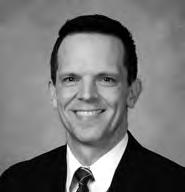
Creative Director Sarah Shepherd sarah.shepherd@beta.org
Managing Editor | Graphic Designer Mike Roupas, Iowa ’10 mike.roupas@beta.org
Director of Media Relations | Senior Writer Justin Warren, SMU ’10 justin.warren@beta.org
Director of Digital Media Sutton Jacobs, Wittenberg ’18 sutton.jacobs@beta.org
Publication Printer Royle Printing Sun Prairie, Wisconsin
Sketched on a non-descript rock in South Africa resides what is believed to be the oldest example of storytelling ever discovered. Some 73,000 years old, it is followed by cave art in Spain dating back 65,000 years. Primitive by today's standard, they represent our instinct to record the human condition and share it for the benefit of others.
Practices have of course evolved through the centuries, now prompted each night through a child's adorable bedtime request of his or her parents: "Mommy, daddy, read me a story."
To be sure, stories make order of our chaotic world and help us hand down a moral code of how we hope to live together. One need reflect no further than on the centerpiece of daily conversation with friends and family, or teachings in the classroom and workplace, to understand we are constantly engaged in a state of culture-shaping through storytelling.
So, too, is the legend of Beta Theta Pi.
Yet, with an institution nearly 185 years old – mind you, older than half the states in the Union and all 10 provinces of Canada – it can be a challenge to preserve the volumes of lore that have made Beta one of North America's most respected college fraternities.
Thus, in its 150th anniversary year, this issue seeks to retell a tiny fraction of those Beta stories "carved" in the annals of time – some of our most alluring yet forgotten.
Reproduced in the voice of their original authors, with distinct photography and artwork, Part II of the magazine's sesquicentennial reminds us of a special fraternity heritage that deserves to be told again, and again, and again.
Sincerely and yours in ___kai___,
"In its 150th anniversary year, this issue seeks to retell a tiny fraction of those Beta stories 'carved' in the annals of time – some of our most alluring yet forgotten."
FOREWORD ANNIVERSARY ISSUE PART II | 2023 5
foreword
“I’m an Alpha Phi, PR pro and Beta Mom — A HUGE FAN of your work!!!” — Sandi Straetker, Mom to Matthew Straetker, Creighton ’21 the inbox
unfiltered feedback
magazine feedback
“The 150th Anniversary issue of The Beta Theta Pi reminded me how much we depend on our magazine not only to spread the news throughout the Fraternity, but also to preserve so much of our history. Thank you for taking us through the past 150 years of that journey! It was great to see how the magazine has continued to improve through the years, as well as be recognized for bringing the Beta story to life and keeping us all connected.”
— General Secretary John Stebbins, Emory ’92 “Fantastic issue!”
— Fran DeSimone Becque, Pi Beta Phi Historian and Mom to Bradley and William Becque, Knox ’08
“Congratulations on the very special Beta magazine 150th anniversary issue and the great article on John Stebbins. It is one of the best I have ever seen. At your convenience, please send me John’s email address, as we would like to see if he can speak to our Dallas/Ft. Worth Beta Alumni Club this spring. Yours in _kai_,” — Pax Glenn, North Carolina ’58


“The magazine continues to be excellent. I hadn’t really thought that much about the changes to it discussed in the recent issue, but now that I know about them, I really appreciate
them. The physical copy is nice and high-quality; like you said, I can’t just throw it away without reading it (even if I wanted to, which I don’t). Great job to the team – keep it up.” — Matt Walczewski, Truman State ’03
“Still one of my favorite reads. Love the progression here!” — Mikel Derby, Iowa ’92
“Until nine years ago, I dragged with me all over the world every one of my copies of the magazine. But the weight and transport costs overwhelmed me, and I gave up. Thank God for digital...it’s all there and EVERYONE can access the entrancing tale of our excellent and wonderful Fraternity, which seems to blossom and flourish given its imperishable ideals, principles and underlying love which we gather up to lay at Wooglin’s feet.” — Tom Lipton, Western Reserve ’63
“Terrific issue. Absolutely filled with amazing Greek knowledge.”
— Greg Hollen, Phi Kappa Tau Fraternity
“How do I start receiving it again?” — Tim Wilson, West Virginia ’86 (Brother Wilson was followed up with by the Beta staff, but all brothers can get back on the mailing list in a few quick seconds at beta.org/update.)
6 THE INBOX THE BETA THETA PI
serious mistake generational preferences
“In retrospect, it has become very obvious that Amherst made a serious mistake in 1970 when it diluted the excellence of an Amherst education by doing away with fraternities. Beta Iota Chapter was a special place that laid the foundation for a bunch of guys who went on to become special people: doctors, lawyers, teachers, CEOs, and even a great professional football player. Fraternities like Beta are an important part of a college education, so please keep up all of your good work. -kai-” — Dave Morine, Amherst ’66

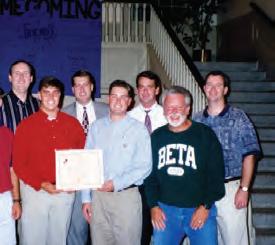

beta suicides
“Just returning home to Florida, where I enjoyed Volume 150, No. 1 of The Beta Theta Pi magazine. Thank you for speaking the truth about Jamey C. Rootes, Clemson ’88, and Richard A. Symms, Idaho ’20, about their suicides. Although I knew neither of these Beta brothers, reading about their suicides still caused me to stop, think and pray for their families. So, I will ask this question about Beta Theta Pi: Does Beta have any kind of grief team, or outreach out to chapters when a Beta (brother or pledge) commits suicide?” — Mike Manis, Indiana ’79
“New merch is fire.”
— Quinn Leanza, Cincinnati ’25
“Who designs these off-brand products? Are there no branding guidelines for logo/color/ symbol usage? Will most likely never buy any of these.” — Bob Kumaki, Illinois ’82
“Shoutout to the AO for the drip.”— Beta Nu Chapter, University of Cincinnati
“How about producing sweatshirts with embroidered Beta coat of arms or t-shirts/long-sleeve shirts with just the Beta dragon or dragon shield?”
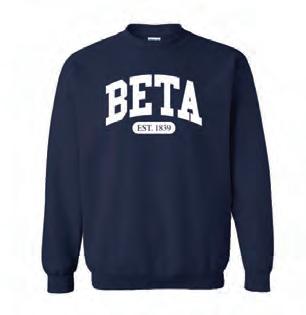
— Patrick Hidalgo, San Diego State ’91
“About to get dripped out.” — Davis O’Connell, Alabama ’26
“Back-in-the-day
... had all of them.”
— Dean Eiden, WisconsinOshkosh ’94
In celebration of the Beta magazine’s 150th anniversary, merch from the “Vintage Collection” apparel campaign was inspired by photos from yesteryear rediscovered in the Beta archives. While the campaign has ended, check out the Fraternity’s new photo archives at beta.org/digitalarchives.


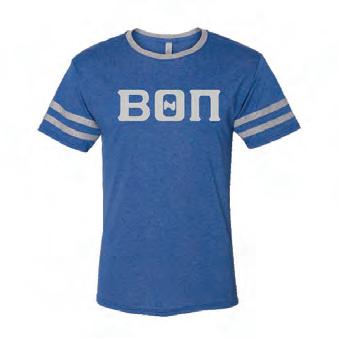
THE INBOX ANNIVERSARY ISSUE PART II | 2023 7
Hanover 1995
Johns Hopkins 1994
fraternity updates
Fall Term Yields Solid Recruitment Class
While slightly under fall 2021 performance when chapters charged back following two years of the pandemic, last fall the Fraternity notched its sixth largest recruitment class since 1839. Visit beta.org/recommend to refer young men to any of Beta’s 140 chapters.

Undergrads Relinquish Charter
Citing campus challenges and the chapter’s inability to recruit and retain members, on January 27 General Secretary John Stebbins, Emory ’92 , announced the undergraduate chapter’s unanimous vote to relinquish the Delta Epsilon charter at the University of Puget Sound in Washington. The charter will remain in care of the Board of Trustees.
King Named DEI Commissioner

Fraternity Introduces New Property Management Program
The General Fraternity House Corporation recently created the GFHC Property Management, LLC to provide full management services for chapter homes owned by local Beta house corporations. The objective of the new program is to operate chapter homes effectively and efficiently, allowing house corporation members to spend their time focused on the more fun aspects of the Fraternity like alumni engagement and chapter support. The Epsilon Gamma House Corporation at Central Michigan is the first to participate in this new service offering.
In December, General Secretary John Stebbins, Emory ’92 , appointed former staff Director of the Men of Principle Initiative and Beta Foundation Advancement Director Ryan King, Southern Illinois ’01, as Beta’s new volunteer Commissioner on Diversity, Equity and Inclusion. King follows Beta’s first DEI Commissioner, beloved Beta Great Bill Lowry, Kenyon ’56
newsworthy
Term New Members Fall 2015 2,546 (1st) Fall 2016 2,465 (4th) Fall 2017 2,508 (2nd) Fall 2018 2,413 (5th) Term New Members Fall 2019 2,363 Fall 2020 1,633 Fall 2021 2,499 (3rd) Fall 2022 2,391 (6th)
Fall 2023 Bid Day, University of San Diego
beta events greek headlines
March 2023
16 Naples Alumni Assoc. Luncheon Naples, Fla. elainemerriam@aol.com
April 2023
15 George Mason Installation A rlington, Va. blong22@gmu.edu
21-22 Wisconsin 150th Anniversary Madison, Wis. rst72badger@gmail.com
Fraternity Man and Three Sorority Members Murdered at Idaho
Four University of Idaho students were fatally stabbed in an off-campus residence in the early hours of November 13, 2022. The four students were all members of the Greek community: Sigma Chi Ethan Chapin (center); Alpha Phi Kaylee Goncalves (left); and Pi Beta Phis Xana Kernodle (right) and Madison Mogen (top). Chapin was a freshman, Kernodle was a junior, and Goncalves and Mogen were both seniors. On December 30, 28-year-old Washington State University doctoral student Bryan C. Kohberger was arrested in Monroe County, Pennsylvania, on four counts of murder in the first degree and felony burglary. A preliminary hearing to determine probable cause is set for June 26.
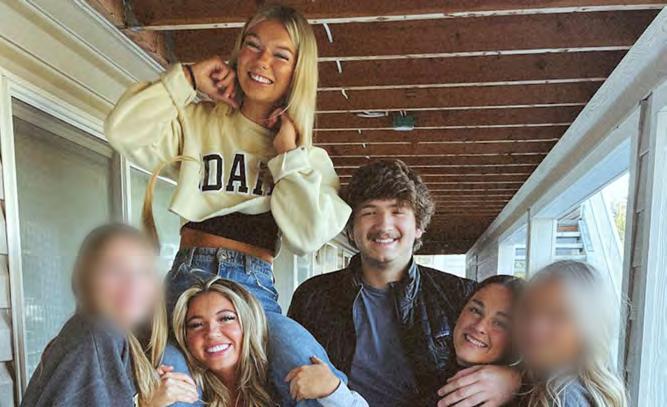
Delta Gamma Teacher Shot by 6-Year-Old
Delta Gamma alumna Abigail Zwerner, a first-grade teacher at Richneck Elementary in Newport News, Virginia, was shot in the hand and upper chest by a 6-year-old child on January 6. Hailed for her composure by moving all 20 students out of the classroom while seriously injured, Zwerner remained in the hospital for two weeks following the incident. Administrators at varying levels within the education system were relieved of their duties upon discovering at least three warnings surfaced prior to the shooting. Zwerner is at home recovering while the investigation continues.
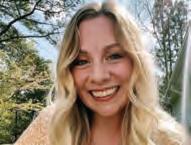
Phi Delt Killed in Michigan State Shooting

Michigan State students and staff experienced their worst nightmare on February 13 when a gunman entered Berkey Hall and began firing in a classroom full of students. Continuing his shooting spree at the student union, three students were killed and five remained in critical condition at press time. Chapter President Brian Fraser, Phi Delta Theta, was among the students killed. The gunman eventually took his own life.
28-29 Spring Board of Trustees Mtg. Portland, Ore. jeff.rundle@beta.org
May 2023
5-6 Kansas 150th Anniversary L awrence, Kan. 150th.kansasbeta.org
June 2023
3-7 Wooden Institute, Session 1
10-14 Wooden Institute, Session 2
24-28 Wooden Institute, Session 3 O xford, Ohio beta.org/wooden
August 2023
3-6 184th General Convention Dallas, Texas beta.org/convention
October 2023
14 Centre 175th Anniversary Da nville, Ky. henry.w.snyder@outlook.com
28 Wabash 175th Anniversary Crawfordsville, Ind. alumni@wabash.edu
Learn more at beta.org/calendar. Upcoming alumni event? Email specifics to beta@beta.org!
NEWSWORTHY ANNIVERSARY ISSUE PART II | 2023 9
CINCINNATI BENGALS

MIKE BROWN, DARTMOUTH ’57
JACKSONVILLE JAGUARS
SHAD KHAN, ILLINOIS ’70

alumni news
lifelong brotherhood
Another notable gridiron Beta, Umpire Bryan Neale, Indiana ’92, was first to signal for medical assistance when Bills Safety Damar Hamlin went into cardiac arrest during a game against the Bengals on January 2.

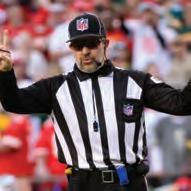
Khan’s Jaguars, Brown’s Bengals Make the Postseason
Two Beta NFL franchise owners saw their teams take the league – and specifically the American Football Conference – by storm during the 2022 season.


The Jacksonville Jaguars, bought in 2011 by Shad Khan, Illinois ’70, and led on the field by former Clemson quarterback and first overall pick in the 2021 draft Trevor Lawrence, won the AFC South division title for the first time in five years before overcoming the Los Angeles Chargers 31-30 in the wild-card playoff round. Unfortunately, the team fell short one week later in the divisional round, losing 27-20 to the Kansas City Chiefs.
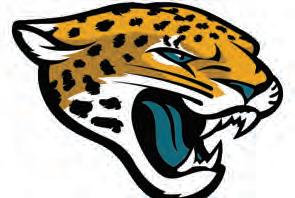
At the end of the regular season, the Cincinnati Bengals, owned by Mike Brown, Dartmouth ’57, finished in the top three of the NFL’s power rankings. Led by superstar quarterback Joe Burrow, the team’s pursuit of back-to-back Super Bowl appearances saw wins against the Baltimore Ravens and Buffalo Bills in the wild-card and divisional rounds, respectively, before losing to the Kansas City Chiefs 23-20 in the conference championship.

_
alumni news
A | Kicking Ax
You don’t want to mess with Jesse Rood, Nebraska ’19, a firefighter who broke the ax-throwing world record last July at the opening ceremonies of the 38th annual Cornhusker State Games. Rood’s throw sailed 90 feet – smashing the previous record of 75 feet – and earned him an official certificate from Guinness World Records.

B | Rookie of the Year
After a staggering 16-touchdown rookie season that led his Winnipeg Blue Bombers to the team’s third consecutive championship, receiver Dalton Schoen, Kansas State ’19, took home the Most Outstanding Rookie distinction at the 2022 Canadian Football League Awards. Leading the CFL with 1,411 yards receiving, Schoen was not just the league’s best rookie receiver but arguably its best receiver overall.

C | Back-to-Back Titles
As the Georgia Bulldogs emerged victorious against TCU in the 2023 College Football Playoff National Championship, the 65-7 final score left little doubt that the team’s offensive coordinator, Todd Monken, Knox ’89, deserved significant credit for the back-to-back title run. “The style of football he coaches and the tenacity he has, he’s aggressive,” Georgia offensive tackle Broderick Jones told the Athens Banner-Herald. “We can slow it down. We can go fast. There’s just so many things in our offense that he implements that are great just because we keep the defenses on their toes.” Monken’s success did not go unnoticed. In February, the former Tampa Bay Buccaneers offensive coordinator (2016-18) was once again recruited by the NFL, this time with hopes to turn around the Baltimore Ravens’ offense.

ALUMNI NEWS ANNIVERSARY ISSUE PART II | 2023 11
B C A
Photo: The Canadian Press
Photo: USA TODAY NETWORK | Joshua L. Jones
Conquering Everest
Thirty-nine days after arriving in Nepal and after more than 53,000 feet of total expedition elevation gain, Nate Douglas, Washington ’08, reached the summit of Mount Everest. “The surest way to make your dreams come true is to live them,” Douglas said. “Everest was the most mentally, physically and emotionally challenging thing I’ve ever done.”

D | Grammy Nominated
2022 was a banner year for record mixer Noah “MIXGIANT” Glassman, Loyola Marymount ’22, who was featured on the “Black Panther: Wakanda Forever” soundtrack, earned a platinum plaque for work on Doja Cat’s album “Planet Her,” and scored a Grammy nomination for Best Global Music Album with artist Burna Boy.


E | Take Command
Fans of Dale Carnegie’s “How to Win Friends and Influence People” may want to snag the new release from Dale Carnegie & Associates President and CEO Joe Hart, Michigan ’90, “Take Command.” A modern manual for personal development, Hart’s team filled the book with research and interviews with over 100 high-performing leaders.
F | Rare Sondheim Recording Discovered
Many of the legendary works by composer Stephen Sondheim, Williams ’50, like “West Side Story” and “Out of the Woods,” are household names. Yet most don’t know that his first play – “Phinney’s Rainbow” – was a satire on college life inspired (perhaps to his chapter brothers’ chagrin) by his time in Beta Theta Pi. A mere two recordings from the 1948 show had been known to exist – until recently. In December, the first-ever live recording of the song “How Do I Know?” surfaced on YouTube, sparking hope that Sondheim’s long-forgotten debut title may soon be available for public consumption. Listen to the recording at beta.org/howdoiknow
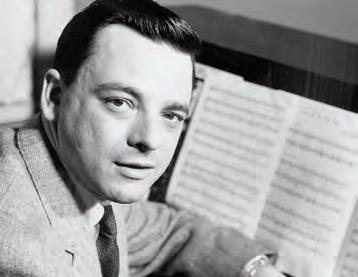
G | Big Screen Honors
The Naples Film Festival named Nate Plotkin, Central Michigan ’22, this year’s “Best International Screenwriter” for his award-winning screenplay “The Trap.”
H | Celebrated Colonel
An executive at Kentucky Farmers Bank, the success of Don Perry, Eastern Kentucky ’86, has made it possible to give back to his alma mater and the northeastern Kentucky area he calls home. As such, he was recognized with the university’s Hall of Distinguished Alumni Award.
I | Sooner State Lawyer
An award-winning veteran lawyer, Jim Hicks, Oklahoma ’82, recently completed service as president of the Board of Governors of the Oklahoma Bar Association.



J | Capital City Beta
A stone’s throw away from the U.S. Capitol in Washington, D.C., Otis McCandless-Chapman, Texas A&M-CC ’20, is composing reports for Congress as a social policy intern at the Library of Congress.

K | Silver Gray Celebrates 100th
Looking spright and spirited at the age of 100, Bob Welsh, Davidson ’44, attended the Trustees’ dinner event at Quail Hollow Club in Charlotte on February 3, keynoted by former North Carolina Governor Jim Martin ’57

ALUMNI NEWS ANNIVERSARY ISSUE PART II | 2023 13 I K
alumni
G H J
news
D
E
F Photo: Flickr | Christopher Michel
alumni news
L | Heroic Action Recognized
In September, Chad Hammer, Oregon State ’04, a member of the U.S. Department of State’s Diplomatic Security Service, was recognized by the Federal Law Enforcement Officers Association with its highest honor, the National Award for Heroism. Hammer was celebrated for his actions securing and evacuating the U.S. Embassy in Kabul, Afghanistan, and subsequent humanitarian operations at the Hamid Karzai International Airport.


M | Major Angle
Joel Angle, Connecticut ’09, was recently promoted to the rank of major in the U.S. Army. Angle’s service as an operations officer on a cyber protection team in the Army Reserve Cyber Protection Brigade was rewarded at a ceremony where he was pinned by his Air Force First Lieutenant wife and young son.

N | Stem Cell Savior
After joining the Gift of Life registry in 2019, Harrison Weisberg, Quinnipiac ’16, was recently called upon to make a stem cell donation and save the life of a 70-year-old leukemia patient. “The whole donation experience is 100% worthwhile,” Weisberg said. “I would absolutely do it again.”

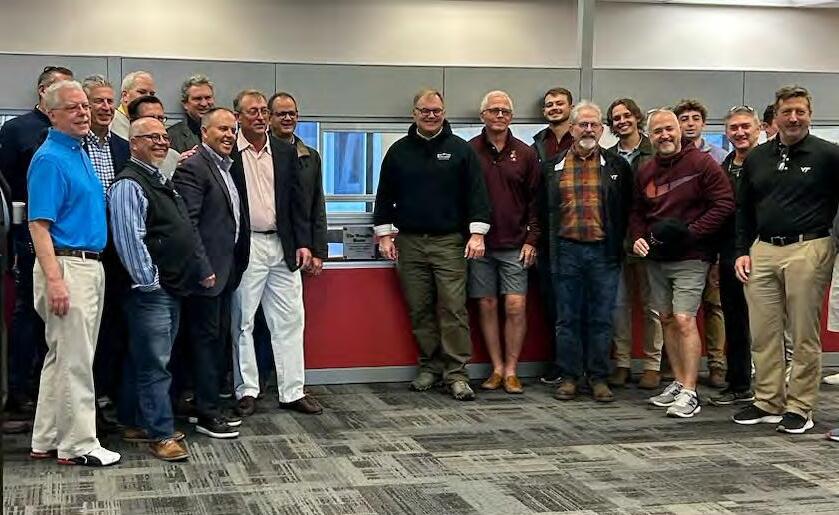
O | The Wooglin Room
Unveiled during the chapter’s 50th reestablishment anniversary last fall, Virginia Tech alumni dedicated The Wooglin Room, a group study space in the Newman Library, through a generous gift to the university. “Giving back to a place that means so much to you is really important,” said project leader Bruce Heterick ’85. “Whether it’s my children or someone else’s, we wanted to make sure that impact is also available to them.” Visit beta.org/thewooglinroom to learn more.

14 ALUMNI NEWS THE BETA THETA PI O L M N
Forbes 30 Under 30
An up-and-coming leader in the esports industry, Alex Gonzalez, Florida International ’20, has been named to the Forbes 30 Under 30 list of 2023. Named the head of Luminosity, a division of Enthusiast Gaming, in March 2022, he quickly became one of the youngest to manage a tier-one esports roster in North America. Among the more than 20 content creators he oversees are top Twitch streamers Felix “xQc” Lengyel and Nick “NickEh30” Amyoony. Gonzalez is also an adjunct esports professor at Shenandoah University.

Beta has long been known for its deep bench of volunteers who tirelessly serve the Fraternity they love. It's a hallmark characteristic of one of North America's greatest college fraternities.
Yet, the need to enlist talented individuals to coach Beta undergraduates is constant.
As of February 1, some 69 chapters have at least one core advisor opening, totaling 129 volunteer vacancies.
Plus, there are more ways to get involved than just the vacancies listed here. Email volunteer@beta.org to get involved or refer a volunteer!
American Financial Advisor
Risk Management Advisor
Bethany Risk Management Advisor
Boise State
Member Education Advisor
British Columbia
Risk Management Advisor
Butler Member Education Advisor
Risk Management Advisor
Cal Poly Risk Management Advisor
Central Michigan
Member Education Advisor
Chapman
Member Education Advisor
Risk Management Advisor
Cincinnati Financial Advisor
Clemson Recruitment Advisor
Colorado Recruitment Advisor
Columbia
Financial Advisor
Connecticut
Chapter Counselor
Financial Advisor
Recruitment Advisor
Risk Management Advisor
Dayton
Chapter Counselor
Member Education Advisor
Recruitment Advisor
Denison
Financial Advisor
DePauw
Financial Advisor
Member Education Advisor
Recruitment Advisor
Risk Management Advisor
Drexel
Financial Advisor
Eastern Washington Chapter Counselor
Risk Management Advisor
Emory Financial Advisor
Risk Management Advisor
Florida
Financial Advisor
Florida Gulf Coast Recruitment Advisor
Risk Management Advisor
Florida International
Member Education Advisor
Recruitment Advisor
Risk Management Advisor
Furman
Financial Advisor
George Mason
Risk Management Advisor
George Washington Financial Advisor
Recruitment Advisor
Georgia
Financial Advisor
Member Education Advisor
Recruitment Advisor
Risk Management Advisor
Illinois
Member Education Advisor
Illinois State Financial Advisor
Risk Management Advisor
making a difference
Member Education Advisor
Recruitment Advisor
Risk Management Advisor
16 VOLUNTEER VACANCIES THE BETA THETA PI
volunteer vacancies
Indiana Financial Advisor
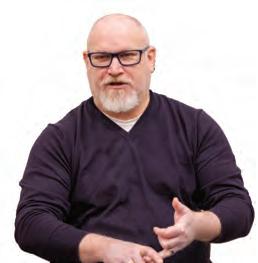
Risk Management Advisor
Kennesaw State Recruitment Advisor
Kentucky Chapter Counselor

Kenyon
Member Education Advisor
Recruitment Advisor
Risk Management Advisor
Loyola Marymount
Recruitment Advisor
Risk Management Advisor
LSU Chapter Counselor
Financial Advisor
Member Education Advisor
Miami (Fla.)
Member Education Advisor
Recruitment Advisor
Risk Management Advisor
Michigan Financial Advisor
Michigan State
Member Education Advisor
Missouri
Chapter Counselor
Risk Management Advisor
North Carolina
Chapter Counselor
Member Education Advisor
Recruitment Advisor
Risk Management Advisor
North Dakota
Member Education Advisor
Northeastern
Financial Advisor
Risk Management Advisor
Ohio Member Education Advisor
Recruitment Advisor
Ohio State
Financial Advisor
Oregon Risk Management Advisor
Pacific Financial Advisor
Pennsylvania Chapter Counselor
Member Education Advisor
Recruitment Advisor
Risk Management Advisor
Rochester Risk Management Advisor
Saint Louis
Financial Advisor
Member Education Advisor
Risk Management Advisor
San Diego State Chapter Counselor
San Jose State Chapter Counselor
Financial Advisor
South Carolina
Member Education Advisor
Risk Management Advisor
Southern California
Financial Advisor
Member Education Advisor
Risk Management Advisor
St. Lawrence
Recruitment Advisor
TCU
Member Education Advisor
Texas
Member Education Advisor
Texas Tech
Risk Management Advisor
UCLA
Member Education Advisor
Recruitment Advisor
Risk Management Advisor
Vanderbilt Chapter Counselor
Member Education Advisor
Virginia
Financial Advisor
Wabash Risk Management Advisor
Washington
Financial Advisor
Washington & Jefferson Chapter Counselor
Member Education Advisor
Washington in St. Louis
Financial Advisor
Risk Management Advisor
West Chester Chapter Counselor
Financial Advisor
Member Education Advisor
Recruitment Advisor
Risk Management Advisor
Westminster
Member Education Advisor
Recruitment Advisor
William & Mary Chapter Counselor
Financial Advisor
Member Education Advisor
Recruitment Advisor
Wisconsin
Member Education Advisor
Wisconsin-Oshkosh Recruitment Advisor
“Beta is a wonderful place to put your heart and talents to work if you have the time to volunteer. The gentlemen typically need a little guidance and this is a way to steer them in the correct path of life while they have a great social experience."
John Lauder, Florida State '97 Chapter Counselor for the Eta Xi Chapter at High Point
VOLUNTEER VACANCIES ANNIVERSARY ISSUE PART II | 2023 17



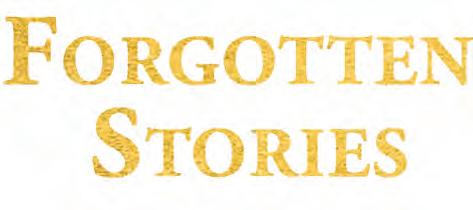 edited by Martin Cobb, Eastern Kentucky ’96 designed by Mike Roupas, Iowa ’10
illustrated by Sutton Jacobs, Wittenberg '18
edited by Martin Cobb, Eastern Kentucky ’96 designed by Mike Roupas, Iowa ’10
illustrated by Sutton Jacobs, Wittenberg '18
Knox or Marshall?
Some 70 years after the Fraternity's founding, Shepardson settles the rightful claim to "Pater of Beta Theta Pi." page 20
hen one recalls the age of Beta Theta Pi, it can be hard to fully comprehend the depth of history associated with one of North America's most senior college fraternities. Considered the "oldest of the large," just sixth in order of founding following 1776's Phi Beta Kappa, Beta lore is steeped in tradition, moments of heroism and sacrifice, acclaimed leadership rivaled by few and, yes, periodic shortcomings that have humbled a very proud fraternity.
Those Beta legends are imparted to bright-eyed young men donning shields of white and gold, and they are handed down to each generation with reverence. Yet, without fail, young and old brothers alike routinely remark upon hearing an epic tale, "Wow, I never knew that."


Thus, as Part II of The Beta Theta Pi magazine's 150th anniversary commemoration, and in a nod to its 927 issues spanning some 85,000 pages since 1872, these are just a few of Beta's best "Forgotten Stories."



The Photograph and Wooden Leg of John Holt
Duncan

One brother's persistence leads to the discovery of jaw-dropping Beta artifacts. page 24
An Historic Lantern Returns to Ole Miss Beta's merger with the Mystic Seven is symbolized by a sacred, 1800s relic from The Grove. page 29
The First Fraternity House?

Zeta Chapter at Hampden-Sydney College in Virginia gives birth to living together as brothers. page 30
The Ladies Who Are Betas
Women have played important roles in Beta Theta Pi, even earning some their own cherished initiation. page 32
Beta's
Controversial Pink and Blue



Debate over the Fraternity's official colors has been intense and as old as their adoption in 1879. page 34


Beta's Secondary Badge

Proposed initially as a badge for women, then alumni, Beta's secondary badge routinely sparks intrigue. page 36

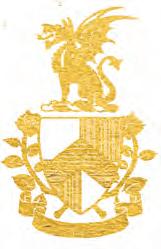



19 | The | ForgoTTen STorieS
Articles have been edited for length and style, and photos retouched for effect.
FORGOTTEN STORIES
KNOX OR MARSHALL?
 by Francis W. Shepardson, Denison 1882 The Beta Theta Pi | February 1911
by Francis W. Shepardson, Denison 1882 The Beta Theta Pi | February 1911

Some 70 years after the Fraternity's founding, Shepardson settles the rightful claim to "Pater of Beta Theta Pi."
ere's a health to Pater Marshall and them of '39. Should that be the reading of a popular song line? I have recently examined with much interest a copy of the original Constitution of Beta Theta Pi. It includes, in addition to the simple plan of government for the association, the obligations required of each initiate. It is signed by Marshall himself in this fashion, "S. T. Marshall, Original Founder." Accompanying this document sent to the Iowa Wesleyan chapter in 1892 was an autograph letter from Marshall in which the following paragraph appears:
"I conceived the idea of this society and wrote the Constitution and finished it before anyone else ever knew about it.

I then showed it to John Reily Knox and he approved it and signed it and then we got Jas. G. Smith in and we three started Alpha Chapter. Smith was my classmate, but Knox was a class ahead of us and was a senior while we were juniors."

Here is a definite claim to priority over Knox. The name of the Fraternity, its objects and its first obligations are all included in the "original Constitution" whose authorship Marshall asserts for himself in plain words. Marshall often declared in his later years that he and not Knox was the real founder of the Fraternity. Has there been a mistake? Did the nearness of Knox to Cincinnati in the years when that city was Fraternity headquarters crown him with a degree
of glory that led by and by to the loving title, "Pater," and finally so fooled his memory as to make him believe he really was the founder of the Fraternity instead of Marshall? Some of Marshall's relatives and friends think that the honor has been misplaced. The controversy should be settled if possible.
The historical materials are not abundant. They consist of the recollections of the two men, the records of the Alpha Chapter, and a letter written by Knox in 1843, in answer to an inquiry about "the first movements of the Beta Theta Pi." This letter and the Alpha records are, of course, much better "sources" than "recollections" of either Marshall or Knox after 40 or 50 years.



The Beta Theta Pi, Vol. VII, No. 2, November, 1879, contains "Recollections of 1839, by John Reily Knox" and also a letter from John Reily Knox to E. B. Stevens, dated Greenville, Ohio, April 14, 1843. In this letter Knox indicates the "winter session of '38-9'" as the time when the idea of forming a secret association first suggested itself to his mind.


He states:


"In some of our conversations on the subject Taylor Marshall suggested the idea of building up a society which might unite the benefits without the disadvantages of the Alphas [Alpha Delta Phi]. I told him I had thought of it but was afraid that we could not succeed.
"Marshall often declared in his later years that he and not Knox was the real founder of the Fraternity. Has there been a mistake?"
But if you know Marshall, I need not tell you that he is one of the most sanguine men in existence. The idea once started he would not give it up until I set to work."
In the Marshall "original Constitution" the name, Beta Theta Pi, appears. The Greek words are used and their meaning is indicated. But Knox says:
"In the first place I got the Greek Lexicon and turned it over several times in search of a name. The present one was finally selected."
He indicates that this was the first thing he did after the talks with Marshall. In the Knox letter of 1843, written less than four years after the Fraternity was founded, he states:
"We then went to work on the Constitution. You have seen the draught as it was originally presented. On that I spent my leisure time for a week or more and many were the long consultations which Taylor and I held over that. Night after night up in the 'old wing' we revised and re-revised until we got it to our satisfaction, though necessarily imperfect, for it was altogether an experiment with me, as I had nothing to go by but imagination and I believe Taylor was equally inexperienced."
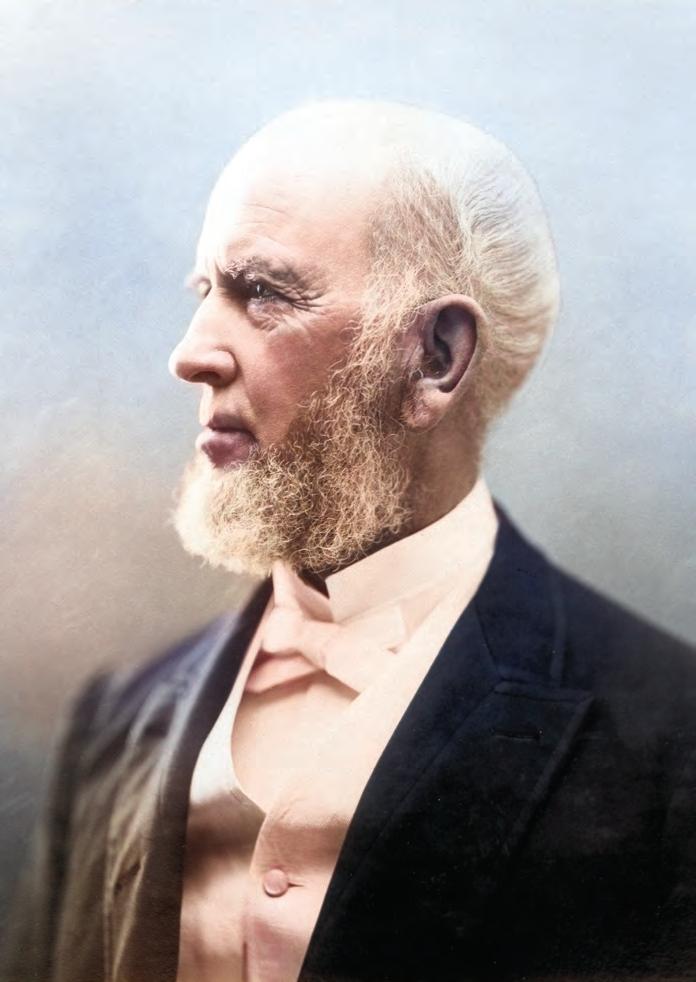
21 | The | ForgoTTen STorieS
John Reily Knox, Miami 1839, has long been considered the principal founder of Beta Theta Pi.
"The next question was, whom shall we connect with us in this matter?"
Then come two sentences followed by a portion of the letter which could not be reproduced, the editor noting "The parts marked by stars are torn from the original manuscript by use and old age." The two sentences are: "The next question was, whom shall we connect with us in this matter? Chas. Hardin roomed next door to Marshall, so we called him in and I initiated he and Taylor."
It is to be noticed that Taylor says: "Then we got Jas. G. Smith in and we three started Alpha Chapter."
In the Knox letter to Stevens, written in 1843, Smith's name is not mentioned at all unless it was in the part that was illegible because of wear and age. In the "Recollections of 1839," written thirty-six years after the letter and, as internal evidence shows, with a catalogue at hand for reference, Knox states that those present at the first meeting were "Brothers Marshall, Linton, Smith and myself," that the meeting was held in Marshall's room, and that, "Soon after this first meeting Charley Hardin, John Duncan and M. C. Ryan, good and true fellows, were added to the faithful band . . . At what time Bros. Johnson and Gordon were added to make up the full number, I do not now recollect."

The two contradictory statements about Hardin attract attention at once. In the 1843 letter, Knox says:
"Many of the circumstances have escaped my recollection in the course of my peregrinations for the last four years."


His memory was not good even then for after describing the unfortunate affair of Grimke Swan and his mock initiation "by Linton, Marshall, Hardin and myself," he relates:
"After we were fairly rid of him, we proceeded in the selection of members.
J. H. Duncan, M. C. Ryan, Tom Gordon and H. T. Johnson were then initiated at successive meetings of the society until we got our complement (9) when we met in general conclave, and proceeded to the election of officers."
That this was an incorrect account the minutes of Alpha Chapter, quoted in Baird's Handbook (p. 13) show. These minutes are written with great formality
 Founder Marshall is credited for his optimism and the enthusiasm that fueled Beta's founding.
Founder Marshall is credited for his optimism and the enthusiasm that fueled Beta's founding.
as if for purposes of exact record. The first sentence reads:
"The following young men, students of Miami University, namely, John R. Knox, Samuel T. Marshall, David Linton, J. G. Smith, Charles H. Hardin, John H. Duncan, M. C. Ryan and Thomas B. Gordon, having associated themselves together, formed and subscribed the foregoing Constitution, laws and objects held, agreeably to previous arrangement, their first regular meeting in the hall of the Union Literary Society at 9 o'clock on Thursday evening, August 8, Anno Domini, 1839."
The order of names is as noteworthy as the formal style. If the custom was followed then that usually prevails in such circumstances, the members signed in the order of their selection. These eight names are not arranged alphabetically or by classes. The first regular minutes give their support to John Reily Knox as the recognized leader in the new association. At the same time they show the untrust-
worthiness of his memory even as early as 1843. Four officers were chosen that night, while Johnson did not become a member until November 14, 1839, after Knox had graduated, and Knox was not present either at that meeting or at the one of October 10, 1839, when Johnson was voted in. At the first regular meeting, "J. R. Knox was then elected to address the society upon the first anniversary of its foundation." The query, why was he chosen for this honor? goes with the other one, why was his name first on the roll?
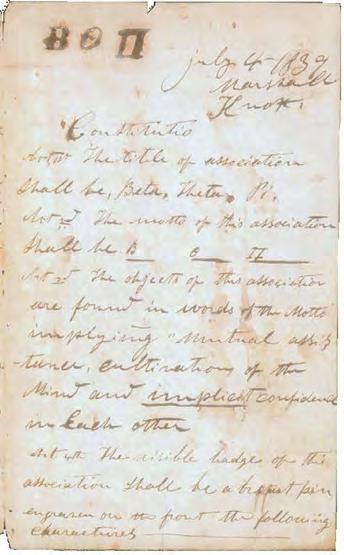
The evidence from the "sources" is not entirely conclusive. But it strongly favors Knox. I do not accept the Marshall claim in its entirety. I believe that Brother Baird reached the right conclusion in the "Handbook" (p. 12) where he says:
"It would seem that both Knox and Marshall had independently conceived the idea of forming such a society, and that it only took shape after it had been mutually discussed."
I am satisfied myself to retain the old words unchanged with, perhaps, a little emphasis on the "and."




"Here's a health to Pater Knox and them of '39."
[Memorandum by the Editor. — The account of the foundation of the Fraternity published in the first edition of the Handbook in 1894, was submitted in proof sheets to both Knox and Marshall. Marshall wrote on the margin, "That seems about right" and returned the sheets. Knox wrote that he thought the minutes of Alpha Chapter were the best guide. Afterwards the editor had two conversations with Knox about the matter and Knox claimed unqualifiedly to be the founder of the Fraternity. He said that he suggested the idea to Marshall and that Marshall fell in with the plan so promptly and readily that it showed he had been thinking of something of the kind. He said to the writer that he believed Marshall did actually write the first clean copy of the Constitution but only after the two of them had written and rewritten it several times. Of course that did not mean that Marshall was the sole author of the document. Knox was a very modest man and not at all self-assertive. He always seemed to be a little dazed by the extent and power of the Fraternity and depreciated his part in it, and he wasn't one to actively push any claim to individual glory in founding the Fraternity, but he evidently considered himself to be the first one of the founders. The writer would further add that he was intimately and long acquainted with Dr. John C. Zachos, Cincinnati 1840, and when the matter was discussed with him he said Knox was regarded as the founder by all of his contemporaries and that there was no doubt about it. In fact, Dr. Zachos always said that Marshall could not have invented the Greek motto from inherent limitations.
 — W. R. Baird]
— W. R. Baird]
23 | The | ForgoTTen STorieS
Pages 1 and 2 of the original 1839 Constitution in Founder Marshall's handwriting –motto and password redacted.
THE DISCOVERY OF THE PHOTOGRAPH AND WOODEN LEG OF JOHN HOLT DUNCAN
by Lloyd E. Thatcher, Mississippi 1911

The Beta Theta Pi | November 1935


f it had not been for William Henry Roberts, an enrollee in the C.C.C. Camp, Miss. F-2, located at Meadville, Miss., and a tornado which passed through southern Mississippi destroying the towns of Gloster and Gillsburg on the night of April 6, 1935, the photograph of Founder John Holt Duncan would still be lost to Beta Theta Pi. This young man and the occurrence of the tornado formed the connecting links in the chain of circumstances which led to the discovery of the photograph, the wooden leg worn by Founder Duncan,
the Greek textbook which he used as a young man which contains his autograph, and some unknown facts of his life.

During the month of February, Roberts did considerable typing for me when I was sending out letters to the Beta alumni in Mississippi. During the course of our association on this task, we discussed fraternities. He told me that one of his uncles was a fraternity man at the University of Mississippi many years ago. He was not quite sure of the name of the organization to which his uncle belonged,
and since it was not Beta Theta Pi, the incident was passed over.
On my return to camp on the night of April 7, I asked Roberts if the tornado had passed in the vicinity of his uncle's home near McComb. He said he had not heard from his people since the storm. I offered to take him down home in my car to find out whether his family had been in the path of the storm. We immediately started for McComb, and found upon our arrival there that the tornado had missed that vicinity by several miles.
 One brother's persistence leads to the discovery of jaw-dropping founder artifacts.
One brother's persistence leads to the discovery of jaw-dropping founder artifacts.
FORGOTTEN STORIES
Upon our arrival at the home of Roberts' uncle, Mr. James P. Harrison, several miles beyond McComb, I had the pleasure of meeting Mr. Harrison who gave me the leads which ended in the discovery of Founder Duncan's photograph and the other mementos listed above.
In the course of our conversation, Mr. Harrison learned I had been connected with the University of Mississippi, and he started asking questions about the societies there. It soon developed that Mr. Harrison had been a student at



"Ole Miss" in 1868-1869 and that he had been a member of the Alpha Kappa Phi fraternity. This fraternity, which was the last remaining chapter of the Alpha Kappa Phi, petitioned Beta Theta Pi in 1879 and received the Beta Beta charter. Perhaps Mr. Harrison is the only living member of Alpha Kappa Phi. After spending one year at the University of Mississippi, Mr. Harrison went to Rensselaer Polytechnic Institute at Troy, N.Y. At the end of the year at Troy, he was called home to take charge of some of his father's plantations. I was delighted to


meet a member of Alpha Kappa Phi, but I soon discovered that I had more cause for rejoicing than this first fact.
We talked on, and I told Mr. Harrison about the later history of Alpha Kappa Phi being now a part of Beta Theta Pi. As conversations sooner or later get to the questions as to where people are born and where they have lived, so did ours. Mr. Harrison told me that he was from Fayette, Miss. Since this was the home of Founder Duncan's family, my next question was: "Did you ever know John Holt Duncan?" To my delight his answer was, "Yes." Mr. Harrison then told me that Judge Duncan was an intimate friend of Mr. Harrison's father and that between the years of 1865 and 1870, Judge Duncan had visited in the Harrison home some three or four times. Our time to return to camp came, and I left Mr. Harrison with the determination to return at the earliest possible moment to obtain all the information with regard to Founder Duncan which I could get.
I reported this experience to President Shepardson and received a reply by return mail asking me to follow up the interview, suggesting questions about Founder Duncan which he would like to have answered. April 13 I went back to see Mr. Harrison armed with a barrage of questions. I took with me a copy of the "Beta Book" and "Beta Lore" to show Mr. Harrison the very meager data which the Fraternity had with regard to Founder Duncan. I spent the evening and the following day questioning, listening and jotting down notes.
25 | The | ForgoTTen STorieS
Thanks to Thatcher, a photo of Founder Duncan (circa 1872) was finally secured in 1935.
"I had the pleasure of meeting Mr. Harrison who gave me the leads which ended in the discovery of Founder Duncan's photograph and the other mementos listed above."
I asked Mr. Harrison to tell me all he could remember with regard to Founder Duncan. The thing that impressed me is the clearness of memory and the accuracy with which he described facts and faces covering the period of his lifetime. Mr. Harrison was born in 1852 and is now in his eighty-third year. Whether it is a fact which happened during the Civil War or whether it happened in Congress last week, or whether it is some scientific development in which he is keenly interested, he displays a most remarkable memory and appreciation of the facts.


Mr. Harrison was a close personal friend of Duncan Holt Chamberlain whose letter to Dr. Shepardson with regard to his uncle, Founder Duncan, appears on pages 182-183 of "Beta Lore." This lifelong friendship more intimate than family ties lasted until the death of Mr. Chamberlain in 1933. It made possible the completion of other links of the chain which led to the discovery of the photograph and other mementos of Founder Duncan. Mr. Harrison was able to give me the names and location of practically all of the living relatives of Founder Duncan. The most of them, I have since interviewed and the information which they gave me will appear in a later part of this account.
Mr. Harrison was a lad in his teens when John Holt Duncan visited in the Harrison home after the Civil War. He described Founder Duncan as a man of medium height, full figure but never corpulent, dark complexioned with a rather rugged face, pompous and formal. His first statement with regard to Judge Duncan was that he was full bearded as was the custom of men at that time. The
photograph taken about 1872 bears out this description. He remembered Judge Duncan was a cripple and walked with a cane, but never heard him mention the cause of his lameness. In after years he heard the story of the cause of the Judge being crippled and of his caring for the family in Missouri ("Beta Lore," 182). He knew nothing of Duncan's life in Texas as the Judge had gone there sometime in the early fifties. He did know that the Judge was never in affluent circumstances. After leaving Mr. Harrison's home on the evening of April 14, I stopped at Summit, Miss., to interview the daughter of Duncan Holt Chamberlain, Mrs. Van Keys. The idea occurred to me that since Founder Duncan had only one sister and that women are more likely to keep family relics than men, that my best chance for finding a photograph, if such were in existence, would be through that line of relatives. I asked Mrs. Keys to tell me what she knew of the family history and if her father had any of the family relics. She told me her father did not have any but she was quite certain there was an old family album at the home of her aunt, Mrs. Jefferson Chamberlain, at the Mounds Plantation near Natchez. The Mounds had been the home of Maybella Duncan during her marriage to Mr. Chamberlain and after his death and her subsequent marriage to Mr. Wade, she spent part of her time at the Mounds with her children. This information interested me for it bore out my theory as to the possibility of finding the photograph.
The following day I went to the Mounds to interview Mrs. Jefferson Chamberlain.

It was here that Founder Duncan's mother died. After telling Mrs. Chamberlain why I had come, she very kindly got out the data which she had – a family album of photographs and the diary of Founder Duncan's mother. Mrs. Chamberlain never knew Founder Duncan personally. We looked through the album and found among the family
 Mounds, the home of Duncan's sister, Maybella, safeguarded a long sought-after photo and signature of Beta's co-founder – both gifted to the Fraternity nearly 100 years after its founding.
Mounds, the home of Duncan's sister, Maybella, safeguarded a long sought-after photo and signature of Beta's co-founder – both gifted to the Fraternity nearly 100 years after its founding.
"I asked Mr. Harrison to tell me all he could remember with regard to Founder Duncan."
"He described Founder Duncan as a man of medium height, full figure but never corpulent, dark complexioned with a rather rugged face, pompous and formal. His first statement with regard to Judge Duncan was that he was full bearded as was the custom of men at that time."
pictures, photographs of Confederate officers and one of Jefferson Davis, a photograph which was marked John Duncan. We decided that in all probability this was the photograph for which Beta Theta Pi had been searching for many years. I asked if I might borrow it and have it copied for the Fraternity and Mrs. Chamberlain kindly consented. I then searched the diary of Founder Duncan's mother hoping to find some reference to him but there was none. The diary revealed the soul of a mother crushed with grief at the death of her three sons—Thomas Holt who was thrown from a horse and killed in 1844, Robert who was killed in battle near Richmond, Va. in 1862, and Randolph who was killed at Vicksburg in 1863. There were repeated entries in the diary on the anniversaries of the death of each of the three sons, but not a single entry with regard to the living children.
After asking Mrs. Chamberlain to search through any old family papers, which she might have, to see if she could find an autograph of Founder Duncan, I went to Natchez to see Mr. Walter Wade, a son of Maybella Duncan by her second marriage. I told him my story and showed him the picture which I had obtained from Mrs. Chamberlain. He told me it was John Holt Duncan and that it was an excellent likeness of his uncle and was taken about 1872. He remembered other photographs of his uncle but said they were no better than the one which I had obtained.
Mr. Wade's memories of his uncle were interesting and the facts related are summarized from several visits with him. About 1872, when Mr. Wade was a boy, John Holt Duncan came back from Texas and spent several years in the Wade home with his sister Maybella Duncan Chamberlain-Wade. Founder Duncan was devoted to his sister. At that time the Wade family was living at Rosswood near Lorman, Miss. Mr. Wade described his uncle as being very studious and a great reader, but mostly of law books, and very dignified. Mr. Wade described him further as being very kind, but when angered would pound the ground with his walking stick. The floors of Rosswood were scarred by the metal tip of his uncle's peg leg.
Having discovered the photograph of Founder Duncan and some interesting facts about his life, I immediately reported to President Shepardson. He asked that I get a picture of Rosswood, the old Duncan home in Fayette and some specific data with regard to the way that Founder Duncan wore his wooden leg.
On April 22 I went to Fayette, Miss., to search for further information.
I spent the greater part of the day searching the records in the office of the Chancery Clerk with the hope that I might find a record of Founder Duncan's admission to the Bar and perhaps some legal documents which he might have executed.
Two days later I returned to Fayette, Miss., to take some Kodak pictures of the Duncan home which is still standing although it has been remodeled.
From Fayette, I went to the Rosswood Plantation which is located about two miles east of Lorman, Miss. This was the home of the Wade family in which Founder Duncan spent several years with his sister about 1870.
It is in a bad state of repair, but I went over to the house and explained to the those living there why I had come and incidentally told them of the scars on the floor which Mr. Wade had told me were made by the peg leg of his uncle.





To my surprise, they told me that there was a peg leg upstairs. I offered them a dollar for the leg, telling them that if it did belong to Founder Duncan that it would be an interesting memento of him, but if it was not, that it was nothing to me except a piece of wood. My next problem was to try to establish the ownership of this leg.
I stopped at the adjoining plantation to visit the descendants of a collateral line of the Wade family who have occupied this plantation since before the Civil War. The family knew that the leg had been there for many years, but none of the present members were living at the time of Founder Duncan's stay at Rosswood. They knew of no one in the vicinity who had worn a wooden leg in their lifetime. I then called on an old doctor who has resided in that community for the past 48 years, and who lives within sight of Rosswood. He told me there had been no one in that community since he had practiced medicine there who had a peg leg.
27 | The | ForgoTTen STorieS
This evidence was convincing but not conclusive, so I went back to Natchez to interview Mr. Wade. I showed him what I had found at his old home and we discussed the possibility of it having belonged to Founder Duncan. The evidence is as follows: There has never been anyone else who ever lived in Rosswood who had a wooden leg. Mr. Wade owned the property until about 15 years ago and has known all the occupants during his lifetime. There has never been anyone else in that community within the past 50 years who was so crippled. The leg is for the right side and for an amputation just above the knee. John Holt Duncan's right leg was amputated just above the knee. Mrs. Chamberlain told me her husband told her that his uncle John had left a peg leg at either the Mounds or Rosswood. It is the opinion of the descendants of the Duncan family that this peg leg is beyond a shadow of a doubt one which their uncle, John, discarded during his stay in Mississippi about 1870. It has all the evidence of being a homemade leg with some of the original straps still on it to identify its being

for the right leg, and is in my estimation the first one which he used after his leg was amputated. In all probability he replaced it with a better one during his stay in Mississippi.
Dr. Shepardson was interested in knowing how Founder Duncan wore his leg, so I inquired of Mr. Wade. He told me his uncle wore it inside of his trousers and then remarked, "The Duncan family were as proud as Lucifer." I suppose this pride caused Founder Duncan to keep his peg leg covered.

A few weeks later I took a trip to Greenville, Miss., to interview Mr. Aubrey Duncan, a son of Charles Duncan. He, too, was interested in my research on the life of his Uncle John. He told me as a child he used to play with the sword and pistol which his uncle carried in the Civil War, and expressed the regret he did not have them to give to the Fraternity. He told me also of a photograph which the family had of Founder Duncan which had written on it a rather complete history of Founder Duncan's life and the
various offices which he held. Among those he remembered a statement with regard to Founder Duncan's connection with Beta Theta Pi. I tried to locate this photograph, but it was undoubtedly destroyed when the home of Charles Duncan burned years ago.
President Shepardson had some correspondence with Mrs. Chamberlain since this investigation started and she has sent to him a Greek textbook which was used by the members of the Duncan family which contains the autograph of John Holt Duncan and his brothers.
The Beta Theta Pi Fraternity is deeply indebted to each of the members of the Duncan family; to Mr. James P. Harrison, their friend and member of Alpha Kappa Phi; to William H. Roberts, the nephew of Mr. Harrison, for the part each one has had in adding to the historical record of Founder John Holt Duncan.
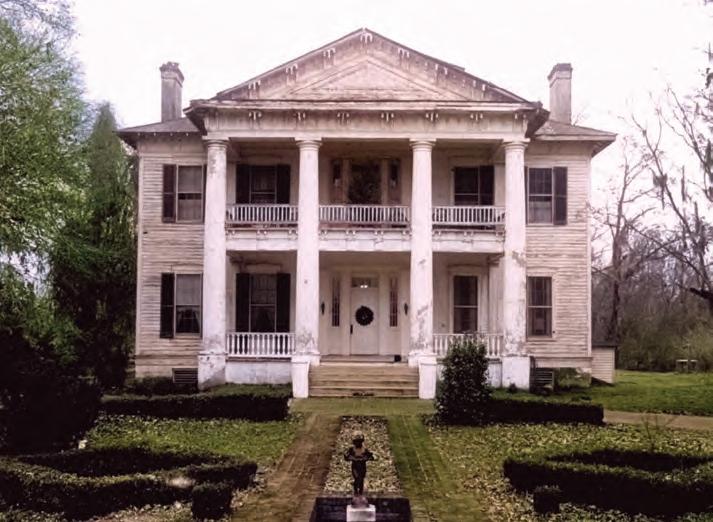
Contrary to all the laws of nature, it was an ill wind that blew us some good.

"It is the opinion of the descendants of the Duncan family that this peg leg is beyond a shadow of a doubt one which their uncle, John, discarded during his stay in Mississippi about 1870."
Duncan lived with his sister, Maybella, in her second home, Rosswood, for several years around 1870. The floor was marked by the iron tip of Duncan's wooden leg.
AN HISTORIC LANTERN RETURNS TO OLE MISS
by Bentley E. Conner, Mississippi 1974
The Beta Theta Pi | June 1973
he Grove at Ole Miss is somewhat of an institution. During football games, alumni gather there to stretch local prohibition laws. In 1971, the Grove was the site of a rock concert. At midnight, sometime in 1858, members of the Star Temple of the Mystic Seven Society met in the Grove to hold their meetings at the bewitching hour. Now the center of a mass of buildings, the Grove then was a secluded nook on the edge of the campus at the University of Mississippi.


As members of the Mystic Seven began each meeting, every member would remove a small folded lantern from his pocket and place a candle in it. When the meeting was over, the lantern was again folded on its hinges and returned to its owner's pocket. One such lamp has found its way to Beta Beta Chapter.

The Mystic Seven was founded at Wesleyan College in 1837. Star Temple was




formed at the University of Mississippi in 1858. Nationally, the Mystic Seven was loosely knit, but locally members were united by strong fraternal bonds. After the Civil War, most Temples were merged into Beta Theta Pi as chapters. Beta Beta was one of the five chapters so merged. Alumni of the Mystic Seven who could be identified were added to the chapter rolls.

This lantern, shown in the photo, was the property of Robert Morrow, a member of Star Temple. The lantern came to be in the possession of Morrow's niece, Mrs. Calvin Brown. She gave it to John H. Fox, Jr., 1920, a distinguished Mississippi Beta, for the purpose of having it returned to Beta Beta. Mr. Fox's death, among other things, delayed the location of the lamp at the house, and it found a path to a small vault in Jackson, Mississippi. When Mrs. John H. Fox, Jr., who holds the love of Mississippi Beta, learned of the lamp, she called John H.
Fox III, Mississippi 1949, and within a week's time the lantern was measured for a permanent position in Beta Beta's trophy case.
On February 4, 1973, the lantern was returned to its home. As far as we can tell, this lantern is the only one in existence and has traveled more than its share of miles. The lantern is an empirical indicator of Beta Spirit, having survived three wars, Reconstruction, and the Depression. It needs a rest and has found a resting place.
29 | The | ForgoTTen STorieS
FORGOTTEN
Beta's merger with the Mystic Seven is symbolized by a sacred, 1800s relic from The Grove.
STORIES
THE FIRST FRATERNITY HOUSE?
by K. Warren Fawcett, Minnesota 1926 The Beta Theta Pi | June 1969



t seems quite possible that the first fraternity "house" was an area occupied by the original Zeta Chapter at Hampden-Sydney College in Virginia. The group had started as Lambda in 1850 (later changed to Zeta) and was the first social fraternity in the commonwealth of Virginia.
The college was the typical classical school of the period, founded by the early Presbyterians in that state on the south side of the Blue Ridge. The founding date was in 1776. Even in 1850 there were no railroads in that part of Virginia
and the college catalogue of that year stated that the school was situated in Prince Edward County, near the town of Farmville and 50 miles west of Richmond. To reach the "easily accessible" college, according to the catalogue, it was necessary for students to travel by canal boats, public stage coach and hired private conveyance.
The physical property of the college consisted of one brick building until 1840 when an administration building was erected. Its first floor was used as a commons for seminary students, and



dormitories occupied the second and third floors. One section of the third floor was under the supervision of Professor Charles Martin, an alumnus of Gamma Chapter at Jefferson College, Class of 1842. Apparently he rented the rooms to members of the Beta chapter who, in letters to Betas in other chapters, often used the dateline "Ratcastle, Hampden Sydney, Va."
This brought many inquiries. What or where is "Ratcastle?" A member of the chapter explained in a letter dated May 18, 1856:
FORGOTTEN STORIES
Zeta Chapter at Hampden-Sydney College in Virginia gives birth to living together as brothers.
"Thus 'Ratcastle' at Hampden-Sydney was the first Beta 'house' and one of the earliest, if not the first, fraternity habitation anywhere."
"In answer to your interrogatories about the name of this place, I will state why it is called by such a euphonious appellation. This area is rented to the students by one of the professors who reserves only one room for himself. When we first came here there was such a number of rats that it was really alarming. They roamed at will ... and we were compelled to take up arms against them. By shooting and catching them, we have nearly broken up the breed, but the name still remains as it was first given."




Thus "Ratcastle" at Hampden-Sydney was the first Beta "house" and one of the earliest, if not the first, fraternity habitation anywhere. For while the building was not exclusively used for that purpose, there was perhaps for the first time, an area of living quarters occupied entirely by members of a fraternity chapter. This was in the 1850s.
With the opening of the Civil War in 1861, the chapter became inactive as most of its members joined the southern forces. Following the war it was revived in 1868. The group seemed to be well established but the removal of the seminary in 1898 to Richmond narrowed the field of prospective members and the chapter declined steadily in strength. Its charter was surrendered during the college year of 1911-1912.

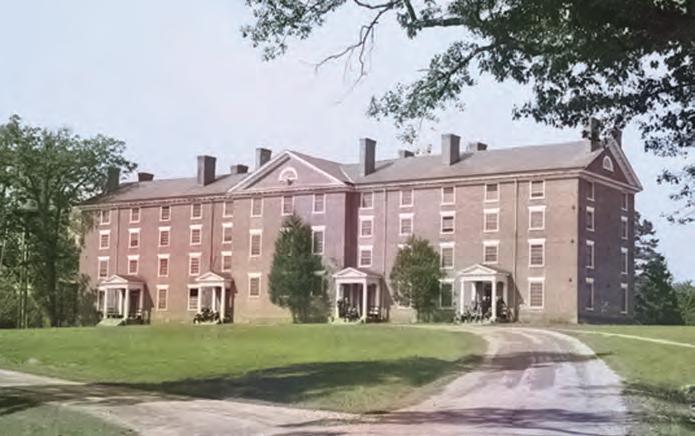
The research upon which this article is based was carried on originally by Karl Wood Fischer, Dickinson/Indiana 1925, famed Beta historian from the 1930s until his death in 1960. He probably knew more about the history of some of the early chapters of Beta Theta Pi
than anyone else in the Fraternity. He was the author of "The Mystics and Beta Theta Pi," "The First Hundred Years of Beta Theta Pi at Indiana University" and many historical articles which appeared in The Beta Theta Pi. The story of Zeta at Historic Hampden-Sydney, 1850-
1912, appeared in the issues of February and March, 1939.
The editor is also indebted to Mr. Wilson B. Heller of the College Survey Bureau for his help in preparing this article.
31 | The | ForgoTTen STorieS
Top: Cushing Hall, home of the "Ratcastle" at Hampden-Sydney College in Virginia, is the oldest 4-story dormitory still in use in the United States. Bottom: Zeta Chapter, 1886. (The gentleman in the center, wrapped in a blanket, was recovering from an illness.)
FORGOTTEN STORIES
THE LADIES WHO ARE BETAS
by John M. Hoffmann, Arizona 1926 The Beta Theta Pi | September 1970
Women have played important roles in Beta Theta Pi, even earning some their own cherished initiation.

ur devoted historian of some years back, the late Karl Wood Fischer, Indiana 1925, undertook to answer the questions concerning members of the female sex who were initiated into Beta Theta Pi. He told of it in an article written for "Beta Lore."
Many questions have been heard because of the recurring stories within the Fraternity concerning female members — active members — of Beta Theta Pi and these led Brother Fischer to make an investigation. He found, for example, that the records of Tau Chapter contain the following:
"Hall of the Charlotte Elizabeth Society, Waveland Collegiate Institute, June 15, 1861."
"According to previous arrangements, as many of the Greeks as could make it conveniently assembled at Waveland today for the double purpose of attending the commencement services and also performed the ceremony of initiation of our worthy and beloved sisters, Miss Anna Bennett and Miss Celia Crocker. Through the influence of the sisters, the use of the Charlotte Elizabeth Society Hall was obtained and the following members of Tau at Wabash chapter were present: Cleland, Dodds, Fairchild, Fulenwider, Harrison, Rhoads, Spencer and Sullivan. The sisters were duly initiated and joyfully welcomed into a full communion of our mystic order and they are entitled to a brother's love and a


brother's protection from every heart in Beta Theta Pi."

Brother Fischer, pursuing his inquiry further, obtained the information because an inquiry had been made regarding the ladies from John Edward Cleland, Wabash 1862, who was then living in Indianapolis and was believed to be the only surviving member of those who were present at the Waveland ceremony. I quote Brother Fischer, "He (Cleland) was asked whether the initiation was a regular one then used by Beta Theta Pi or whether it was a specially prepared form for a 'Sisters Initiation' such as used to be in vogue at Centre College, Westminster College, and one or two

"There are several accounts of membership of ladies in Beta Theta Pi. Some of them being initiated as a reward for services rendered to the Fraternity in keeping chapters alive during the Civil War."
other Beta chapter sites. His answer left no doubt that the young ladies were admitted into full membership in our Fraternity."
There are several accounts of membership of ladies in Beta Theta Pi. Some of them being initiated as a reward for services rendered to the Fraternity in keeping chapters alive during the Civil War. One of these ladies, it was believed, was the mother of the Reverend John Allen Blair, whom the records show was initiated in 1867 by Tau Chapter. A full story of the initiation at Waveland can be found in "Beta Lore" and those who have not fully studied this most interesting book by Brother Shepardson are the losers. Many interesting incidents are related therein.


Then there was the Beta who became a member of a college sorority. He was Dr. James G. Campbell who was then an undergraduate member of Beta Theta Pi at DePauw. He played a very active part
in the founding of Alpha Chi Omega at that time. Brother Campbell wrote it Alpha Kai Omega. This form of name was used until a badge was designed and a change was made for the sake of conformity. He made numerous drawings and badge designs which are still in use in that sorority. He assisted very materially in the writing of their constitution and ritual and it would not be surprising should we discover that many of the ritualistic practices in Alpha Chi Omega resemble those of Beta Theta Pi.


know and we have only to look at the badge of Kappa Alpha Theta to draw our conclusions.
The badge of "Aunt Jennie" Blair. Initiated in 1867, she was a Beta for 59 years.
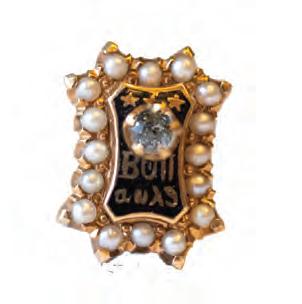
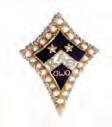
Another interesting legend tells of the Beta daughter who was very anxious to become a member of Beta Theta Pi and when she was thoroughly discouraged by her father who told her to form her own fraternity, she then founded Kappa Alpha Theta. This is fact insofar as we
What is Fraternity? It has been described as being "sentiment." It can also be described to be man's underlying and deeply needed association with his fellow humans in the bonds of brotherhood — one which would be everlasting. May I suggest to all Betas that they again take out the October 1967 number of The Beta Theta Pi and read the Inter Fratres of Brother Seth Brooks, St. Lawrence 1922, former President of the General Fraternity. Who can read this great article and not realize what a wonderful brotherhood we have in Beta Theta Pi?
No wonder the ladies accepted bids.

33 | The | ForgoTTen STorieS
Safeguarding Wabash's ritual and records, Jennie Blair was 28 when the Civil War broke out.
FORGOTTEN
BETA'S CONTROVERSIAL

"PINK AND BLUE"
by Timothy R. Moriarty, Indiana 1978
The Beta Theta Pi | Fall 1981
Debate over the Fraternity's official colors has been intense and as old as their adoption in 1879.

he colors remain, as seldom heard, 'delicate shades of pink and blue.' It had dawned on me recently, when visiting many of the chapters in our Broad Domain, that few if any in our clan are aware of the historic place or origin of the delicate shades in Beta Theta Pi. I have noticed pink and blue handmade Beta flags, pink and blue walls in chapter halls, and pink and blue ribbons on pink and blue programs of the numerous Conventions. Even the forerunner of the current pledge pin was pink and blue. Custom has regulated the law on this subject, since it was first introduced at the epoch-making 1879 General Convention.


It was an era of fundamental decisionmaking. In 1879 Beta absorbed Alpha Sigma Chi, thereby granting five new charters; adopted a new Constitution,

the first one to be published "to the world"; provided for the legal incorporation of the Fraternity; adopted a new ritual (X.Y.Z.), the first one to be printed; adopted a standard badge and jeweler with a commission to the Fraternity; strengthened the magazine; reported progress of the Catalogue; discussed a new song book; and adopted the Fraternity colors.
Two chapters in particular are responsible for the decision of the colors, Ohio Wesleyan and DePauw. A letter written by W. V. Cox, Ohio Wesleyan 1874, in 1879 reads:
"... about the adoption of the Beta colors, I have to say that pink and blue, the present colors of Beta Theta Pi, were first worn in Delaware, Ohio, in 1873 ... There were so many would-be Beta
girls at Monnett Hall and in the town itself that there were not sufficient Beta badges to go round. It clearly would not do under pedagogic conditions for a Greek who had three or four attractive young ladies among particular friends, to cruelly settle down to one girl, for in numbers there is safety. The embarrassing situation was discussed ... the president of the chapter thought that 'color wearing' would solve the problem. Colors, he said, could be effectively worn by all, especially by those who were selected as Beta girls. The liability to wrong interpretations and disagreeable social misunderstandings by badge wearing would be obviated."
The letter continues:
"It being the spring season when light and airy-tissued gowns were generally

STORIES
Representing
to the "excessively religious atmosphere of the Phi Psi chapter." The Phi Psis were staunch Methodists — eight out of 12 were studying for the ministry. Dennison was Episcopalian and very interested in one young lady. "The young lady in question had worn the pink and blue, and by a curious coincidence our DePauw chapter was also using the same combination of colors." Another curious coincidence — around 1875 the Phi Kappa Psis at Ohio Wesleyan and Gettysburg adopted pink and lavender as the Phi Psi colors. At that time the Ohio Wesleyan chapter was the "grand chapter." After nearly 50 years of pink and lavender, Phi Psi adopted red and green in 1922.
Discussion was to have never ended on the pink and blue during the 1879 Convention. Brother Dennison had hearty support but had a difficult time convincing the Silver Grays who strongly opposed the suggestion. The arguments against the shades were numerous:
close of the Convention, pink and blue became a part of Beta lore.




Then in 1903, John I. Covington, Miami 1870, designed the first Beta flag with the new colors — "the result was a dismal failure." The problem was again discussed — "the pink and blue worried many undergraduates" and "the pink and blue amused many alumni."
Brothers grumbled and questioned about the pink and blue for many years; however, it was agreed that no change would take place "as long as Dennison is living." The respect for his efforts on behalf of the pink and blue was apparently strong. "Dennison followed the setting sun to his sure reward in 1929."

Ten years later, at the Centenary in Oxford, the change of the colors came up once more. The Board of Trustees requested that a study be prepared on the colors.
worn, and it being a fact that many of the Delaware girls were blondes, the happy combination was most popular and soon the delicate shades ... were worn by the best-looking girls ... It henceforth became the 'fad.'"
Members of the Theta Chapter originally attempted to promote the pink and blue at the 1873 General Convention, "but members of sedate years, and others with naturally less romance ... and with an utter abhorrence of 'the Frenchy colors' said NO!"
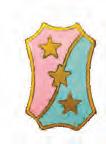
The color scheme was ruthlessly rejected and was not discussed until six years later. Theta Chapter members remained undaunted in their cause for national colors. Brother Walter E. Dennison, Ohio Wesleyan 1877, led the effort. Dennison had been a member of Phi Kappa Psi until he finally resigned due


"The combination of colors, however well it might appear occasionally in the evening sky, was not a strong combination."
"A pink and blue bow on a banquet menu or dance program looked pretty well, but the combination was not at all successful for wall festoons."
"For outdoor display these colors are perfectly unsuitable."
"For the intramural athletic team shirts the combination is nigh ridiculous."
"Pink and blue is not a masculine combination of colors and is not the best color symbolism for a man's fraternity."
The eloquence of impassioned speeches and the admiration of the courage of pink and blue enthusiasts continued. Dennison's girl (later to be his wife) had made pink and blue bows and passed them out to all of the delegates at the Convention. After a hot fight at the
One year later, at the 1940 General Convention the "change of colors" committee voted five to one to recommend that the colors be changed to crimson and white. The Convention voted as follows:
"It seems to be universally taken for granted that had we no colors, pink and blue would be one of the last combinations to receive favorable consideration, but since we have had pink and blue since 1879, no change is advisable."
We have had fun poked at us by our sisters, daughters, Sweethearts and wives for the pink and blue. But it appears as if they got us into this predicament in the first place back in 1873. The pink and blue has found its way into the "Beta Songbook" which accurately reflects the history, ritual and tradition of our Fraternity. Sweethearts and wives and Beta girls are not to be forgotten when one speaks of Beta Theta Pi — they have been beside us all the way through Conventions and Beta life. The colors are a lasting tribute to them.
35 | The | ForgoTTen STorieS
the purity and harmony of unsullied friendship, pink and blue are also the colors of the sunrise and sunset. Top, ribbons originally denoted Beta new members. Left to right, new member pins of 1893, 1894 and 1897.
"A pink and blue bow on a banquet menu or dance program looked pretty well, but the combination was not at all successful for wall festoons."
FORGOTTEN STORIES


THE HISTORY OF BETA'S SECONDARY BADGE
by Archivist H.H. Stephenson Jr., Miami 1939 The Beta Theta Pi | Winter 1982
or the fall issue, we wrote of the "secondary badge" of John Ichabod Covington, Miami 1870. What was this "secondary badge?"
For many years prior to 1872, the year in which the "secondary badge" was adopted, there had been interest in such a badge (sometimes referred to as the "skeleton/skeletal" badge). It evidently was wanted for feminine purposes, although urged as something alumni might wear instead of the "primary badge." Three Beta historians have written about the "secondary badge" viz, William Raimond, Baird, Stevens 1878/ Columbia 1882; Francis W. Shepardson, Denison 1882/Brown 1883, and George M. Chandler, Michigan 1898.
Minutes of 1856, 1858, 1860 and 1864 include references or committee reports on possible "secondary badges" including a watch-key badge, but apparently nothing ever reached the production stage.
During the 1872 Convention, an Alpha Chapter committee, composed of seven members, presented its recommendations. (One of its members was John Covington. Four were alumni rather than undergraduates.) The committee submitted the following design:
"Gold laurel wreath, in skeleton, not more than five-eighths of an inch in diameter; bearing three gold stars at left, top and right side of wreath, respectively, the stars marked with the Greek letters


Beta, Theta, Pi, in order as above named; the wreath-band bearing the chapter letter in Greek, and the ends of wreathband bearing the letters Alpha, Omega, Lambda, Theta (all above lettering to be in black enamel); on reverse side of wreath the name of owner; in center of wreath a diamond with skeleton supports. All the insignia to keep the same meanings and significations as set forth in the Constitution."
The Convention accepted this proposal provided it would be a "secondary and unofficial badge."
Our historians differ as to who actually designed the "secondary badge" originally, and two rival jewelers proceeded

 Proposed initially as a badge for women, then alumni, Beta's secondary badge routinely sparks intrigue.
Proposed initially as a badge for women, then alumni, Beta's secondary badge routinely sparks intrigue.
to manufacture it with, not surprisingly, differing results.


Brother Chandler wrote in Beta Leaflets, (Vol. I: 1914-1915): "Charles T. Thompson, Denison 1873, who owned one of these badges, told me it was designed by Charles J. Seaman, Denison 1871, and himself. He indicated the room in one of the (Denison) dormitories (later named Marsh Hall) in which the design was made under his own eyes. He also stated there were but nine of them ever made, the first going to Seaman and the second
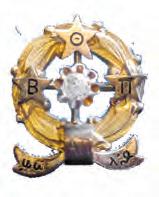
to himself. This statement accords with 'memories of my boyhood as I remember seeing the badges worn in Granville in the early 1870s and always understood they were designed by that chapter.'" Chandler added further: "A possible solution of the problem is that Alpha Chapter accepted in a slightly-improved form the Seaman design."
The Alpha committee included in its report that Duhme and Co. of Cincinnati would manufacture the badge at a price of $8, but reductions would "be made if adopted by the Fraternity and larger orders given."
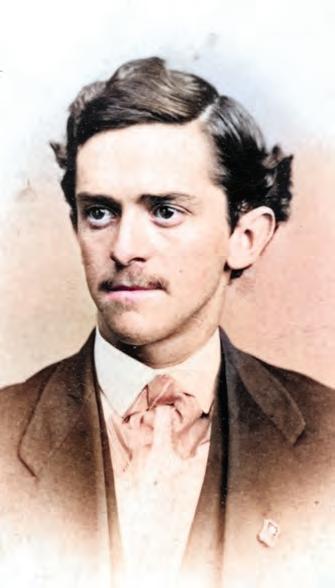
In the June 1873 issue of The Beta Theta Pi, the editor wrote as follows:
Secondary Badge. "Messrs. Kirby & Son, who for so many years and with so much satisfaction to us have manufactured our badge, have just gotten up a number of secondary badges in accordance with the design adopted at the last National Convention. The Messrs. Kirby have followed more faithfully the design adopted, not making the wreath of wheat as Duhme and Co. have done, thus destroying its significance, but of laurel as presented. This adds greatly to the beauty of the pin, making it heavier and richer and leaving smaller space between the gem and the wreath. With these changes we can proudly boast that no fraternity in the land has so beautiful a pin. While this pin can never take the place of our badge; while we do not wish
it in any case to be known as our distinctive mark; yet, as a piece of Beta jewelry, we are very glad it has been so beautifully gotten up. The fact that this pin is an unofficial badge makes it allowable to vary the gem. We heartily recommend those wishing to get this pin to purchase it from the Messrs. Kirby, not only because their design is by far prettier of the two, but because they have served us long and faithfully and, more than all, are helping to support our paper. We must help those who help us."
Brother Shepardson summarized the "rival jewelers" matter in his book, "Alpha Eta, The Story of Beta Theta Pi at Denison," as follows:
"This early conflict of rival fraternity jewelers has its element of humorous interest. The magazine smoothed the ruffled feeling of the Kirbys who had advertised regularly. It remained a matter of opinion as to the relative beauty of the two designs; and, as the feminine demand seemed quickly supplied by such Betas as were able to purchase two badges, at a time when many were not sufficiently in funds to buy one for themselves, the secondary badge soon disappeared into the realm of the curious, the great majority of members not even knowing that there ever was such a badge authorized."


Since 1951, there has been in the archives one of the secondary badges, presumably manufactured by Kirby and Son; the "heavier and richer" type. Owned initially by William P. Gundry, Wisconsin 1875 (Roll No. 9 on that chapter's roll), it was presented to the Fraternity by Quay H. Findley, Western Reserve 1911.
The Covington badge, received this year, of a lighter design than the Gundry one, undoubtedly was manufactured by Duhme and Company.
Indeed, there is cause for rejoicing that our archives contain both "secondary badges."
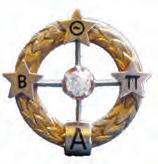
37 | The | ForgoTTen STorieS
John Ichabod Covington, Miami 1870
Secondary badges of (left) John I. Covington, Miami 1870 (Roll No. 155), and (right) William P. Gundry, Wisconsin 1875 (Roll No. 9).
"The Convention accepted this proposal provided it would be a 'secondary and unofficial badge.'"

Looking for graduation gifts and accessories, or to update your supply of Fraternity gear? Beta Theta Pi has two online stores for you! BetaSpirit.com is the one-stop-shop for Beta-branded items from apparel to recruitment resources. TheBetaShop.com brings together merchandise from a variety of licensed vendors in one shopping experience.
Pictured: Edson Lui F. Valdisimo, Boise State '22






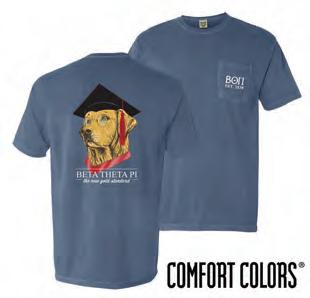


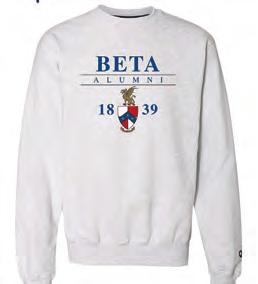
ANNIVERSARY ISSUE PART II | 2023 | 39 beta theta pi
SPRING COLLECTION grad • golf • gifts
Graduation Honor Cord $4.60 | BetaSpirit.com
Graduation Stole $47.82 | BetaSpirit.com
Beta Black Nike Performance Polo $59.95 | TheBetaShop.com
Callaway Black Players Towel $43.06 | BetaSpirit.com
Callaway Warbird Golf Balls $39.47 | BetaSpirit.com
Comfort Colors Retriever Grad Tee $35.95 | TheBetaShop.com
Beta Color Block Rain Jacket $76.95 | TheBetaShop.com
Beta Gray Canvas Duffel $54.95 | TheBetaShop.com
Beta Alumni Champion Crewneck $54.95 | TheBetaShop.com
Drop the Puck for Mental Health


While competitors on the ice, Betas from the Gamma Omicron Chapter at British Columbia teamed up with Phi Delta Theta brothers to defeat stigmas around mental health. "To me, Drop The Puck allows us to participate in the perfect balance of charity and competition," said Chapter President Bradley Cooper '23 (left). "Having such a strong rivalry in this game fuels all of us to put our best effort in through fundraising."
The two chapters did just that in their fifth Drop the Puck Challenge, raising more than $35,000 for the Canadian Mental Health Association (CMHA). Avicenna Centre for Brain Health, a mental health clinic co-founded by Brother Arhum Rana '23 (above, center in gray coat), was the title sponsor of the 2022 event. Since 2018, UBC Betas have directly impacted their local community by giving $134,601 to the Vancouver-Fraser branch of the CMHA.

campus life student highlights
campus life
IFC Presidents
Brothers across the Broad Domain have proven why Beta Theta Pi is the leadership fraternity. Yet again, more than 10 chapters boast leadership at the highest interfraternal level on campus. Learn more about Betas leading IFC at beta.org/2023-ifc
1. Cameron Goodwin-Schoen, Case Western Reserve ’24


2. Ben Wenner, Cincinnati ’24

3. James Triplett, Denver ’25

4. Peter Manev, Drexel ’23





5. Landen Bold, Florida Gulf Coast ’24


6. Andres Arzola, Florida International ’25
7. Jordan Rose, Florida State ’24
8. Braeden Boyle, High Point ’24
9. Ryan Anderson, Iowa ’25
10. Jack Harting, John Carroll ’24

11. Colter Koch, Louisville ’24
12. Nick Zingales, Sacred Heart ’24
13. Ishan Dhawan, Utah ’24

14. Kyle Harris, Virginia Tech ’24
A | Paint Night
Iowa State brothers joined their Greek Week partner, Kappa Kappa Gamma, for a Bob Ross-themed social and attempted their best painting of a mountain range. Instead of happy trees, Brothers Drew Stoufer '26, (left) and Mason Westerberg '26, (right) drifted from directions and painted portraits of their favorite Betas: each other!
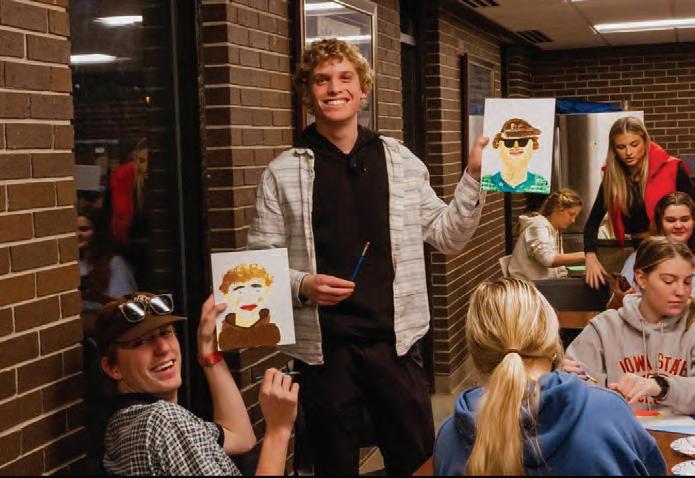
B | Tournament of Roses
Pursuing his passion for the sports industry, Hank Przelenski, Loyola Marymount '23, was selected to participate in the Rose Bowl Game Mentorship Program. The program allowed him to network and learn from the top professionals in the business, not to mention field access at "The Granddaddy of Them All."


C | The Power of Will
Brothers from the John Carroll chapter hosted "Cookout for Sarcoma," grilling up burgers and hot dogs for supporters of their philanthropy, The Power of Will. The organization supports sarcoma patients and was established in memory of Eta Epsilon Brother Will Hudson '17
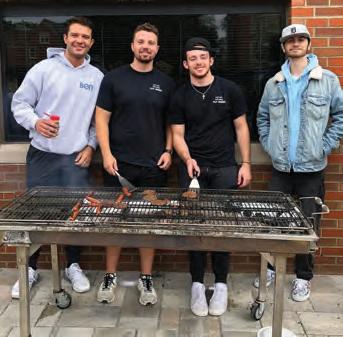
CAMPUS LIFE ANNIVERSARY ISSUE PART II | 2023 41
A
B C 4 1 7 9 10 13 14 5 2 6 3 8 11 12
campus life
D | Fraternity Growth
More than 125 men of principle have been recruited as re/founding fathers at seven campuses: Appalachian State (32), Colorado State (8), Illinois State (20), Samford (22) and West Chester (7). Last but not least, pictured are the 22 brothers who established Beta's new chapter at UNC Wilmington.

E | Meet the Entrepreneur
After learning about software as a startup business model, Brother Preston Rhodes, Cincinnati '24, founded Neoteric Solutions. In partnership with the university's Center for Entrepreneurship, his efforts have helped launch other student startups by providing free resources like website templates and automation software.
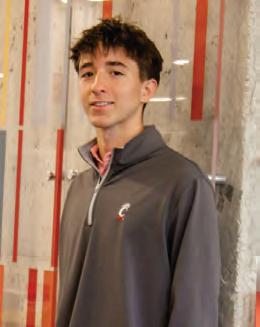
F | The Politics of Dress Codes
Joining his professors, Brother Miles Koniver, Furman '25, presented at the Southern Political Science Association Annual Meeting in January. Their research investigated the effect of dress codes in state legislatures on reproducing or affirming gender, racial or cultural power structures.

G | Raising the Trophy
In an intrafraternal rumble, Missouri Betas returned to the ice against the brothers of Alpha Tau Omega in the second annual BeStrong29 Puck Challenge. Zeta Phi brothers reigned supreme, defeating their opponents 7-5 in friendly competition. The event raised $15,000 for the BeStrong29 Foundation, which supports those affected by spinal cord injuries in honor of Mizzou alumnus Mick Deaver, Alpha Tau Omega.

42 CAMPUS LIFE THE BETA THETA PI
D G E F
Be The Match
The Alpha Nu Chapter at Kansas stepped up to help Brother Luke Karel '26, (pictured) who will need a bone marrow transplant after his leukemia relapsed in November. The chapter partnered with Be The Match and nearly 300 KU students were swabbed at the Beta house and added to the national marrow registry. Learn more about Brother Karel's story at beta.org/bethematch
(Fun Fact: While not a match for his Beta brother, Chapter President Adam Jolles '24, was matched as a donor after a separate swab event in August, leading to him donate to an elderly woman in critical need.)
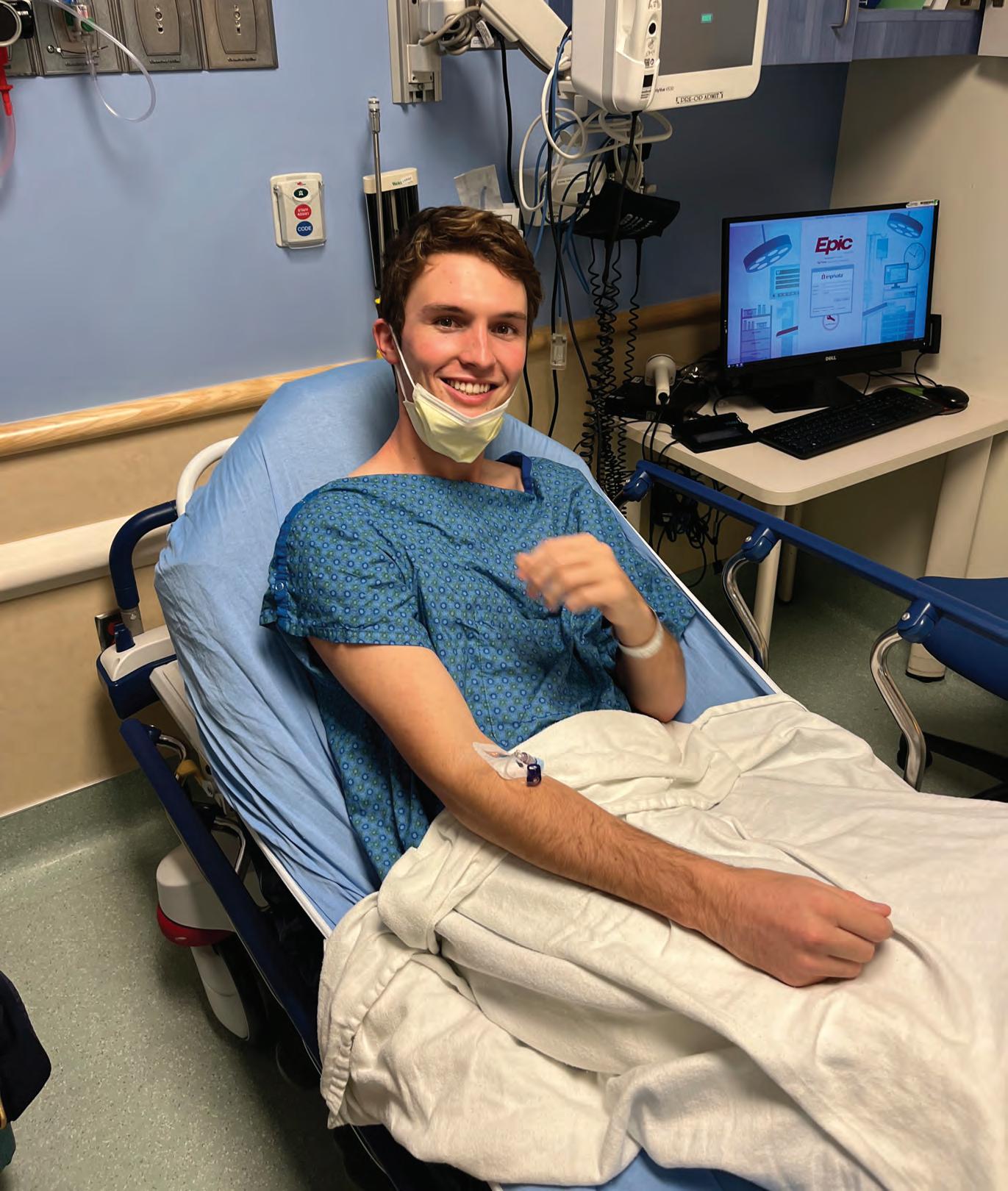
Brothers on Set
Working on their final thesis, the Elon trio of (left to right) director Connor Thomas '23, lead actor Brett Turnbull '24, and director of production Jonathan Pensiero '23, developed a short film titled "Finding Us." The story follows an emotional journey of a young man who, after a double date with his best friend, tries to save his friendship while pursuing the woman he realizes he truly loves.

H | Denver Brothers Think Big
Brother James Howell, Denver '26, (second from right) hopes to make drug overdoses a thing of the past. His team developed thePatch, a wearable device that can detect overdoses by measuring the user's vital signs and could even administer naloxone and contact first responders in the event of an emergency. Brother Howell pitched the concept at Denver's quarterly Madden Challenge and a panel of experts treated the venture to first place overall, which came with a $2,000 cash prize.
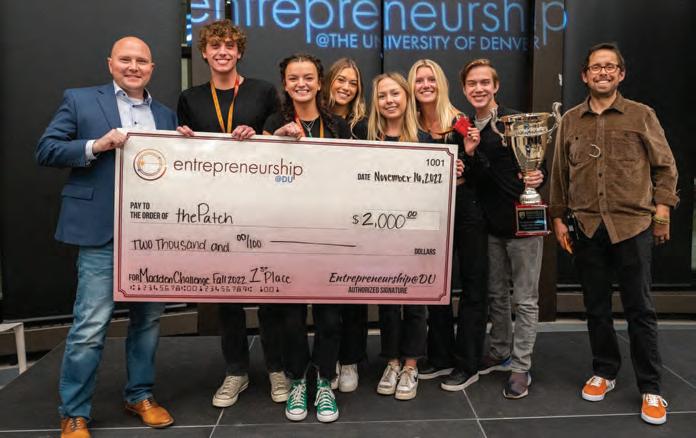
I | Beta Roses for Valentines
It was the perfect Valentine's Day gift for secret — or maybe not so secret — admirers. Miami brothers and Gamma Phi Beta sold roses and handwritten notes for delivery to significant others or friends. The effort raised $1,270 for Women Helping Women, which supports survivors of gender-based violence.

campus life
Undergraduate Commissioners
Since 2019, the voices of Undergraduate Commissioners have been invaluable in guiding the Fraternity, representing their peers with the Board of Trustees and, as of 2022, with the Foundation Board and General Fraternity House Corporation. Recently named by General Secretary John Stebbins, Emory '92, six brothers join continuing Undergraduate Commissioners Jack Corby, Elon '22, and Nathan Satterfield, Michigan '23, in their prestigious roles. These brothers have already immersed themselves in Fraternity business, having attended the February joint board meetings in Charlotte. Learn more about this year's Undergraduate Commissioners at beta.org/2023-ugc.
Board of Trustees
1. Alex Houlton, George Mason ’23
2. Liam Traynor, Lawrence ’23
3. Max Gauger, Texas ’23 Foundation Board of Directors





4. Jack Corby, Elon ’22
5. Collin George, Embry-Riddle ’22

6. C.J. Fovozzo, John Carroll ’23 General Fraternity House Corporation


7. Nazar Abbas, Miami ’24
8. Nathan Satterfield, Michigan ’23
J | Reaching New Heights
Brother Burkley McCarthy, Wabash '24, took to new heights while studying abroad in South Africa, making his way to the summit of Mount Kilimanjaro, which is 5,895 meters—or 19,341 feet—above sea level. "What better way to end the semester than on top of the continent?" he said.

CAMPUS LIFE ANNIVERSARY ISSUE PART II | 2023 45
H
4 1 7 8 2 6 3 5 I J
BLACK TIE OPTIONAL
– Solid dark suit or tuxedo

– Pressed white dress shirt
– Dark, conservative tie
– Handkerchief
– Cufflinks
– Dark leather shoes and dress socks
deciphering the dress code
An event invitation noting guests should arrive in “black tie” dress sends a clear message: wear a tux. Between tailcoats and graphic tees, though, exists a wide range of dress code jargon even the most fashion-forward Beta might struggle to decrypt.
Conservative dark tie and handkerchief
Sweater or nice casual shirt

Dark leather shoes with dark dress socks
SEMI-FORMAL
– Dark suit preferred, though conventional patterns like stripes are A-OK here
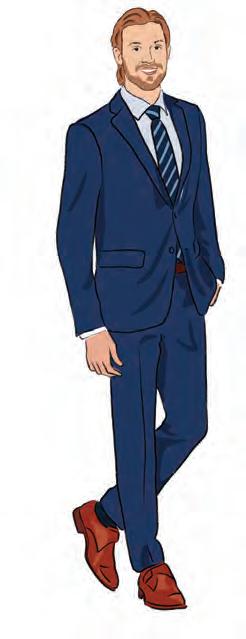
– Solid or subtly patterned dress shirt
– Conservative tie
– Dark leather shoes and dress socks
BUSINESS CASUAL
– Sports jacket, blazer and tie optional
– White, color or patterned collared shirt
– Khakis, chinos or your trouser cut of choice
– Lace-up or slip-on shoes or boots
Khakis, chinos or another kind of trouser

SNAPPY CASUAL
– Sweater, polo or nice shirt
Note: nice ≠ sweaty gym gear
– Chinos or jeans
(khaki shorts if attending a Beta-favorite “resort casual”event)
– Approachable leather or canvas shoes
STILL IN DOUBT?
Level up!
It’s always better to slightly overdress.
46 CUT AND POLISHED THE BETA THETA PI
cut and polishedrefining men of principle

BETA.ORG/RECOMMEND Re cruit Gentlemen, Scholars, Leaders. BETA TEHTA PI est. 1839 Vice President of Recruitment Phillip Dickey, George Mason ’25, is “all in” at the 2023 Keystone Regional Leadership Conference in Cincinnati. Developing Men of Principle.
chapter eternal in loving memory
Forever Remembered
Notices of Beta brothers and Sweethearts who passed within the last two years and were reported to the Administrative Office between October 27 and February 13 are included in this listing.
Report a Beta’s Death
Visit beta.org/deceased or contact Beta’s receptionist at 800.800.BETA or officemanager@beta.org to report a death.
Donate to the Archives
Ask loved ones to donate your Beta badge and important Beta artifacts to the Fraternity’s Archives and Museum in Oxford.
Memorial Gifts
Memorial gifts can be made at beta.org/gift or with Director of Development Laura Lednik at 800.800.
BETA. In lieu of flowers, consider naming the Beta Leadership Fund in your own obituary.
Beta Burial Service
Beta’s public burial service ritual can be accessed at beta.org/burialservice
Friends of Beta
Lorraine C. Alleman, April 1, 2021
Patsy Coburn, April 30, 2022
Janet Fryman, Dec. 31, 2022
Joan Ghrist, June 18, 2022
Mike Hurst, Oct. 16, 2022
Bernidene Merrill, March 9, 2022
Scott Newton, Dec. 23, 2022
Megan Wu, June 1, 2022
Alabama
Patterson B. Alward ’23, Jan. 26
James F. Garbe ’68, Nov. 3, 2022
Amherst
Dwight J. Hartzell ’51, Oct. 13, 2022
Steven R. Koch ’68, Dec. 17, 2022
Bowling Green
Douglas G. Grace ’93, Nov. 14, 2022
British Columbia
David R. Robinson ’85, Oct. 15, 2022
Case
Frederick K. Fischer ’53, Oct. 12, 2021 c
James A. Ramsey ’59, Dec. 30, 2021 c
Cincinnati
Walter S. Faught Jr. ’49, Nov. 6, 2022 c
Joseph M. Laubenthal ’66, Nov. 7, 2022
James W. Rusk ’86, Nov. 23, 2022
Colgate
William P. Blaisdell ’51, June 2, 2021
Michael A. Harding ’72, Jan. 12, 2021
Colorado Mines
William E. Bruce ’59, Oct. 30, 2022
Morton S. Cecil ’52, Jan. 9, 2022
Columbia
Harry W. Fritts ’46, Nov. 16, 2022 c
Louis J. Tangorra ’65, Nov. 8, 2022
Cornell
Joseph C. Bowen ’64, Nov. 8, 2022
Dartmouth
Jake Crouthamel ’60, Nov. 7, 2022 c
William C. Lang ’51, March 12, 2022
Davidson
Bobby F. Maner ’49, Nov. 24, 2021 c
Junius B. Stroud III ’51, May 17, 2022
Denison
David M. Hughes ’75, Jan. 23
William H. Wagner Jr. ’57, Oct. 22, 2022 c
Denver
William B. McKown ’66, Nov. 25, 2021 c
Jay D. Tesch DDS ’62, May 9, 2022 c

DePauw
Paul E. Wright ’50, Oct. 5, 2020
Duke
Sam T. Hooper ’54, Aug. 11, 2022 c
Robert Q. Jones ’51, July 17, 2022
George L. Otis Jr. ’51, Dec. 9, 2020
Rolf H. Towe ’59, Oct. 3, 2022
Ronald E. Wingerter ’54, Dec. 28, 2022 c
Eastern Washington
William A. Elixman ’92, Oct. 7, 2022
Florida
Joseph A. Evans ’56, Sept. 19, 2022
Georgia Tech
John H. Doggett Jr. ’60, Thomas R. Gardner ’50, Oct. 26, 2021
Alton G. Hartley ’71, Oct. 19, 2022
Hanover
Richard L. Danner ’59, July 24, 2021
William A. Welsheimer ’51, Jan. 11, 2022
Illinois
George Donnelly ’65, Nov. 22, 2022
John W. Veirs ’51, Aug. 6, 2021
Indiana
Charles R. Sheets ’51, Jan. 8
Patterson Alward
Alabama ’23
Jan. 26
Described by his Beta brothers as “upbeat and extremely charismatic ... one who never failed to put a smile on the faces of those around him ... and an incredible friend and even better brother,” Alward died by suicide.
Iowa
Everett W. Munsell ’49, Jan. 20, 2022 c
Iowa State
Dean H. Fritchen ’51, Nov. 9, 2020
Kansas
Jay D. Decker ’85, Nov. 13, 2022
L. E. Stollenwerck ’51, Oct. 28, 2022
Kansas State
Joseph P. Henderson ’51, Dec. 13, 2022
Knox
Gerald E. Gill ’53, July 23, 2022 c
Lawrence
Thomas C. Van Housen ’51, Feb. 2, 2022

Maine
Sterlin C. Clockedile ’64, March 19, 2021
Miami
Walter R. Elliott ’51, Feb. 22, 2022
Robert H. Kurz ’58, Nov. 11, 2022
Gordon R. McPherson ’47, Jan. 27, 2021
James C. Solarek ’54, Dec. 23, 2022 c
Michigan
R. D. Kissinger ’57, Jan. 3
Michigan State
David W. Dexter ’85, Aug. 19, 2022
Zachary D. Massey ’24, Dec. 13, 2022
Gerald H. Triplett ’57, Dec. 28, 2022
Minnesota
James R. Hansen ’51, Jan. 26, 2022
Mississippi
William B. Cooper Jr. ’63, Aug. 31, 2022 c
Missouri
Marvin F. Hanigan ’54, Nov. 17, 2022 c
Jake Crouthamel

Dartmouth ’60
Nov. 7, 2022
Instrumental in helping create the Big East in 1979, opening the Carrier Dome in 1980 and hiring championship-winning coach Jim Boeheim, Crouthamel served as Syracuse’s athletic director for 27 years.
Charles J. Spener Jr. ’56, Dec. 5, 2022 George Donnelly
Illinois ’65
Nov. 22, 2022
Co-captain his senior year, Donnelly was a member of the 1964 Illinois Rose Bowl team. He was first team All-Big Ten and an All-American, and was the No.13 pick in the 1965 NFL draft by the San Francisco 49ers.
48 CHAPTER ETERNAL THE BETA THETA PI
Flags indicate Betas who served in the United States or Canadian armed forces.
Missouri-Kansas City
Brett A. Knapp ’01, Oct. 16, 2022
Nebraska
William T. Greer ’51, Sept. 7, 2022
North Carolina
Robert E. Winton ’68, Nov. 7, 2022
Northwestern
Ryan J. Letcher ’06, Nov. 19, 2022
Ohio
William T. McCalla ’52, March 24, 2022 c
George A. Menster ’49, Nov. 6, 2020
James W. Powers ’56, Dec. 20, 2022 c
Richard R. Reinhold ’54, Dec. 3, 2022 c
Daniel P. Rose ’56, Sept. 22, 2022 c
Ohio State
Kenneth H. Chard ’47, Aug. 19, 2022
William E. Shively ’51, Nov. 13, 2020
Ohio Wesleyan
Thomas K. David ’78, Oct. 19, 2022
Keith P. Eiken ’57, Feb. 3 c
Bruce E. Layton ’51, Nov. 26, 2022 c
James E. Meredith ’54, Dec. 22, 2022 c
Byron M. Shepard ’48, Jan. 30, 2022 c
Oklahoma
Benjamin E. Bell ’46, Feb. 13
Guy L. Berry III ’71, Nov. 7, 2022
Oklahoma State
Charles R. Drummond ’65, Nov. 4, 2022
Kyle A. Eudaly ’06, Feb. 3
Charles A. Knoepfler ’75, Jan. 13
Anthony J. Sadler ’75, Oct. 28, 2022
Loyde H. Warren ’62, Jan. 1
Oregon State
Robert D. Dietsche ’61, Oct. 3, 2022 c


Penn State
Thomas Z. Richards ’51, Jan. 12
Pennsylvania
William G. Bower Jr ’58, Nov. 1, 2022 c
David S. Forrest ’52, Nov. 25, 2021
Alan R. Scott ’43, Feb. 5, 2021
Purdue
William W. Bassett ’60, Jan. 14 c
Frank W. Rahe ’64, Oct. 22, 2022
Bruce W. White ’75, Jan. 19
Rutgers
Richard R. Lawrence ’62, Oct. 26, 2021
Bruce B. Smith ’56, Nov. 23, 2022 c
Sewanee
Norborne A. Brown Jr. ’57, Nov. 30, 2022
Daniel L. Colella ’84, Dec. 16, 2022
Glenn P. Totman ’60, Aug. 28, 2021
SMU
Jack R. Coleman ’54, Oct. 27, 2022 c
John A. Graml ’62, Jan. 29 c
South Dakota
Arthur F. Smith Jr ’51, Oct. 13, 2020
Southern California
Douglas L. Shurtleff ’68, Dec. 8, 2022
St. Lawrence
Robert B. Baxter ’51, Sept. 28, 2021
Herbert C. Heller Jr. ’51, March 5, 2022
Harry R. Kahler ’50, Jan. 14 c
Gerald F. Walton ’50, Oct. 28, 2022 c
Stanford
John W. Knowlton ’51, July 9, 2022
Tennessee
John F. Miller ’77, Dec. 21, 2022
Texas
Thomas P. Wood MD ’51, Dec. 16, 2020
Texas Tech
Mark C. Hall ’70, Nov. 20, 2022
Tulane
Robert M. Boulet ’57, March 20, 2021
UC Berkeley
Maurice E. Huguet Jr. ’58, Nov. 28, 2022
UC Irvine Gregory Y. Yee ’11, Jan. 4
UC Santa Barbara
Matthew A. Trehub ’91, Jan. 1, 2022
UCLA
Gary Cunningham ’70, June 26, 2022
Vanderbilt
Gerald L. Ewell ’51, Dec. 1, 2021
James D. Holliman Jr. ’50, Nov. 10, 2022
Virginia
James D. Atkinson Jr. ’52, Feb. 13, 2022 c
John M. Berkley ’54, Oct. 21, 2022 c
Washington
John P. Tate Jr. ’50, Dec. 7, 2022
Washington in St. Louis
Otis S. Farry ’57, April 3, 2022
William J. Fiegenbaum ’54, Dec. 15, 2022 c
Stephen P. Krupp ’81, Jan. 14
Washington State
Bruce D. Buchanan ’60, Nov. 6, 2022

West Virginia
Charles K. Kane ’52, July 2, 2021 c
Western Reserve
Peter J. Calistri ’54, Dec. 16, 2021 c
Westminster
David M. Lindley ’63, Dec. 10, 2022
William M. Penney Jr. ’51, May 26, 2021
Eric F. Tremayne ’67, March 1, 2022 c
Hugh P. Williamson Jr. ’64, Nov. 29, 2022 c

Wichita State
Robert W. Elliott ’63, Oct. 21, 2022 c
Willamette
Russell G. Day ’51, May 3, 2022 c
Wisconsin
Delfin J. Beltran MD ’50, Dec. 4, 2020

Bruce A. Larson ’69, Sept. 22, 2021
Wittenberg
Wendell A. Schick ’77, Oct. 20, 2022
Yale
Alfred Sedgwick Jr. ’50, April 27, 2021
Dave Dexter
Michigan State ’85
Aug. 19, 2022
Longtime district chief and regional director, Dexter was initiated onto the George Washington chapter roll in 1997 for his support during the chapter’s establishment.
Zach Massey
Michigan State ’24
Dec. 13, 2022
Youngest son of Jerry Massey, Michigan State ’92, and younger brother to Drew Massey ’22, Zach heartbreakingly died by suicide.
C.J. Spener
Missouri ’56
Dec. 5, 2022
Loyal brother and longtime volunteer on the house corporation of his Zeta Phi Chapter, Spener was a dedicated member of the St. Louis Beta Alumni Club.
Bruce White
Purdue ’75
Jan. 19
Hotel developer and former Purdue trustee, White was a major benefactor to Beta Mu’s chapter house. Purdue’s school of hospitality is named in his honor.
John Graml
SMU ’62
Jan. 29
A central Beta figure in Houston, Graml helped found and was a decade-long house corporation president for the Delta Upsilon Chapter at the University of Houston.

Greg Yee
UC Irvine ’11
Jan. 4
Correction: In the last issue, Daniel M. Chandler Jr., UCLA ’59, and Alan Goudy, Willamette ’51, were mistakenly listed in Chapter Eternal. Thankfully, both brothers are alive and well, and Beta’s staff apologizes for the error.
Recognized as a “hard-charging breaking news reporter” for the LA Times, Yee served as Beta chorister and historian and editor in chief for the student newspaper.
CHAPTER ETERNAL ANNIVERSARY ISSUE PART II | 2023 49
beta eponyms
worldwide tributes
Greatest Third Baseman of All Time Honored at Nike Headquarters


From backyard games with kids on the block to a day at the ballpark with friends and family, generations have experienced the joy of “America’s favorite pastime.” Interestingly, this year’s Major League Baseball Opening Day on March 30 will include all 30 teams playing their first game of the season, a first since 1968. Recognizing the significance of the annual sporting tradition, Betas can always reflect on one of their own: the Philadelphia Phillies’ 3-time National League MVP, 1980 World Series Winner and MVP, and Hall of Famer Mike Schmidt, Ohio ’71. Considered the greatest third baseman of all time, one of 14 buildings at Nike’s headquarters bears his name. And Brother Schmidt is certainly in good company. Other buildings are named for sporting greats like Jerry Rice, Michael Jordan, Tiger Woods, Serena Williams, John McEnroe, Mia Hamm, Ken Griffey Jr. and Nolan Ryan.
 One of 14 buildings at Nike’s Oregon headquarters is named for Mike Schmidt, Ohio ’71.
One of 14 buildings at Nike’s Oregon headquarters is named for Mike Schmidt, Ohio ’71.

As the old saying goes, “THERE’S NOTHING QUITE LIKE A BETA CONVENTION.” BETA.ORG/CONVENTION AUGUST 3-6, 2023 184TH GENERAL CONVENTION | RENAISSANCE DALLAS ADDISON HOTEL SAN DIEGO BETAS ENJOY THE COLLEGE FOOTBALL HALL OF FAME WHILE IN ATLANTA FOR THE 183RD GENERAL CONVENTION IN 2022.
“IT’S WHAT YOU LEARN AFTER YOU KNOW IT ALL THAT COUNTS.”
– John Wooden, Purdue
In 2023, Beta’s entire slate of leadership programming returns.
Four sessions of the award-winning Wooden Institute, five redesigned Keystone Conferences, and fully in-person iterations of Presidents Academy, Leadership Summit and Leadership College. All emphasizing recruitment, member education and personal development, and all made possible by the Beta Leadership Fund. Show your support at beta.org/gift

For his enthusiastic participation, Devon McGaughey, Eastern Kentucky ’25, received the honor of wearing the “Kai Cap” at the Wooden Institute in January.

’32
Beta Theta Pi Foundation and Administrative Office Brennan Hall | 5134 Bonham Road | Oxford, OH 45056 | 800.800.BETA


 Matt Fallon, DePauw ’87, and Marshall Gardener-Thompson, UC San Diego ’24, unexpectedly crossed paths last summer on the Camino de Santiago in Spain. Learn more about their chance encounter at beta.org/camino.
Matt Fallon, DePauw ’87, and Marshall Gardener-Thompson, UC San Diego ’24, unexpectedly crossed paths last summer on the Camino de Santiago in Spain. Learn more about their chance encounter at beta.org/camino.


























































 edited by Martin Cobb, Eastern Kentucky ’96 designed by Mike Roupas, Iowa ’10
illustrated by Sutton Jacobs, Wittenberg '18
edited by Martin Cobb, Eastern Kentucky ’96 designed by Mike Roupas, Iowa ’10
illustrated by Sutton Jacobs, Wittenberg '18
















 by Francis W. Shepardson, Denison 1882 The Beta Theta Pi | February 1911
by Francis W. Shepardson, Denison 1882 The Beta Theta Pi | February 1911






 Founder Marshall is credited for his optimism and the enthusiasm that fueled Beta's founding.
Founder Marshall is credited for his optimism and the enthusiasm that fueled Beta's founding.

 — W. R. Baird]
— W. R. Baird]


 One brother's persistence leads to the discovery of jaw-dropping founder artifacts.
One brother's persistence leads to the discovery of jaw-dropping founder artifacts.



























 Proposed initially as a badge for women, then alumni, Beta's secondary badge routinely sparks intrigue.
Proposed initially as a badge for women, then alumni, Beta's secondary badge routinely sparks intrigue.


































































 One of 14 buildings at Nike’s Oregon headquarters is named for Mike Schmidt, Ohio ’71.
One of 14 buildings at Nike’s Oregon headquarters is named for Mike Schmidt, Ohio ’71.


